About SACBC
Nature
The Southern African Catholic Bishops’ Conference (which is comprised of the Catholic Bishops of Botswana, South Africa and Eswatini) is an organisation, approved by the Holy See, of diocesan Bishops and others equivalent in Canon Law, serving in the ecclesiastical Provinces of Cape Town, Durban, Pretoria, Johannesburg and Bloemfontein, in and through which members exercise their pastoral office jointly through the pooling of wise counsel and experiences in matters concerning their common interest in order to promote that greater good which the Church offers humankind especially through formation and programmes of the apostolate which are fittingly adapted to the circumstances of the age.
Our Mission
The mission of the Church conference is to bring bishops together to consult and act on shared interests in areas like education, social justice, and missionary work.
Aims
Aim of the Conference is to foster the spirit of communion within the universal Church and between the particular churches. The particular aim of the Conference is to provide the bishops of the territories mentioned above with facilities for consultation and united action in such matters of common interest to the Church as consultation and co-operation with other hierarchies; the fostering of priestly and religious vocations; the doctrinal, apostolic and pastoral formation of the clergy, religious and laity; the promotion of missionary activity, catechetics, liturgy, lay apostolate, ecumenism, development, justice and reconciliation, social welfare, schools, hospitals, the apostolate of the press, radio, television, and other means of social communication; and any other necessary activity.
In furtherance of the above, the Conference shall be entitled:
- To issue statements of common policy
- To promote and foster any movement, institution or undertaking that shall be deemed consistent with its aim
- To negotiate with the government or with any other person or body
- To provide appropriate means for the achievement of its purpose
Plenary sessions
Aim of the Conference is to foster the spirit of communion within the universal Church and between the particular churches. The particular aim of the Conference is to provide the bishops of the territories mentioned above with facilities for consultation and united action in such matters of common interest to the Church as consultation and co-operation with other hierarchies; the fostering of priestly and religious vocations; the doctrinal, apostolic and pastoral formation of the clergy, religious and laity; the promotion of missionary activity, catechetics, liturgy, lay apostolate, ecumenism, development, justice and reconciliation, social welfare, schools, hospitals, the apostolate of the press, radio, television, and other means of social communication; and any other necessary activity.
In furtherance of the above, the Conference shall be entitled:
- The Conference shall hold two ordinary plenary sessions annually
- An extraordinary plenary session may be convened, either at the request of two-thirds of the members of the Administrative Board, or of one-third of all the members of the Conference
- All members of the Conference shall have a deliberative vote. However, only diocesan Bishops, those equivalent to them in law and coadjutor Bishops have a deliberate vote in the making or changing of the statutes
- Any member of the conference, prevented from attending a plenary session, may nominate one of his clergy to represent him without voting powers. The act of delegation or nomination shall be in writing
- It is desirable that, for fraternal dialogue with the Conference, the representative of the Holy See for the territory of the Conference should be invited to at least the first meeting of each plenary session of the Conference. Furthermore, it shall be in order for him to be present at other meetings of the Conference, either by a special mandate of the Holy See, or by the invitation of the Conference
- It shall be in order for the Conference, through its Administrative Board, to invite non-members to attend meetings of the plenary session
History of the Catholic Church in Southern Africa
Full PDF here: 200 years celebration leaflet
The history of the Catholic Church in Southern Africa begins with the arrival of Bartholomew Diaz at Walvis Bay on 8th December 1487. He appropriately called it the gulf of Santa Maria de Conceicao. The first Mass, celebrated perhaps in late December 1487 or early January 1488, was celebrated on the island of the Holy Cross (named as such by Diaz), just off Port Elizabeth. 10 years later Vasco da Gama, on his way to India, would, on Christmas day, sight the land to which he gave the name “Tierra de Natal”. These explorers also brought missionaries with them, but the priests did not concentrate on evangelizing South Africa. Indeed, there is no evidence of any missionary work during these early days.
Between 1652 and 1795, under the Dutch East India Company rule, Catholicism was forbidden in South Africa. Only occasional visits of priests travelling on Portuguese or French boats were allowed. The same attitude prevailed between 1795 and 1802 under the British rule. In 1804, the Dutch government opted for religious toleration, but two years later, the British rule prohibited again the presence of priests and lost no time in expelling them.
In 1818, Pope Pius VII appointed the Benedictine Dom Edward Bede Slater as the first Vicar Apostolic of the Cape. But he never set foot on South African soil as the Government in London forbade him to go there. He went to Mauritius where he was also the first Vicar Apostolic. Likewise his successor, Dom William Placid Morris also resided in Mauritius, never setting his foot on South African soil. In 1837, a new dawn came with the appointment of Bishop Raymond Griffith, a Dominican, as a third Vicar Apostolic of the Cape and first bishop of South Africa. The history of the Catholic Church as a visible institution began to take shape. In 1847, the Eastern Cape Vicariate was created. Father Aidan Devereux became its first Vicar Apostolic. It was him who invited the first religious sisters to South Africa. In 1852, the first missionaries of the newly-founded congregation of the Oblates of Mary Immaculate, arrived in South Africa.
After many obstacles in establishing missions in South Africa, in 1861, Bishop Jean-Francois Allard travelled to the Kingdom of Lesotho. He obtained a mission from the King Moshoeshoe, the founder of the Basotho nation. This mission was to become one of the strongest Catholic communities in Africa. In South Africa very little had been done for the indigenous people. The first significant result came with the Trappists of Mariannhill in the 1880’s, under the leadership of Abbot Francis Pfanner. They developed innovative missionary methods, combining farming, schooling and preaching. These efforts eventually led to conversions, contributing to the growth of Catholicism in Natal. In 1925, the first South African born bishop, David O’Leary, was consecrated in Johannesburg. But the South African Church still relied heavily on expatriate clergy. It was only in 1948 that a national seminary (for whites) was founded.
In 1951, when Pope Pius XII established the hierarchy in southern Africa, not more than five out of twenty one bishops were born locally. The first four African priests had been ordained at the turn of the century, but it was only in the 1920’s in the diocese of Mariannhill, that the first concerted efforts were made to train a black clergy. This led to the establishment of a national seminary for blacks in 1947.
Despite its late coming on the missionary scene, the Southern African Catholic Church has shown remarkable signs of growth throughout the 20th century. Long seen as a foreign church, it has now gained influence in all sectors of society. At least 8% of the South African population is Catholic, putting it up to the second biggest church in the country after the Dutch Reformed Church. About 80% of its members are black.
Like most Christian Churches, the Catholic Church was relatively slow in opposing apartheid. It labored at the cost of the heritage of segregation that it had shared with the rest of the Church in most pre-liberation colonial situations.
During the first decades of Nationalist rule, the hierarchy often adopted a conciliatory stance towards the government in the hope of maintaining the Church’s network of schools, hospitals and welfare institutions. When in 1953 the government struck at church schools for African children with its Bantu education Act, the Catholic Church fought desperately to retain the educational system seen as its major aid to evangelization.
The Southern African Catholic Bishops’ Conference, created in 1947, made its first pronouncement against racism in 1952 and in 1957, condemned apartheid as “intrinsically evil”. Until the late 1970’s however, there were few acts of defiance against the state. Within the Church itself, a de facto discrimination was practiced at many levels.
In 1970’s, under the influence of the Vatican Council and spurred by protests from black clergy, catholic opposition to apartheid started to intensify. In 1972 a move began to desegregate the seminary. In 1976 the decision was taken with regard to both seminaries and schools. The Soweto uprising of 1976 led to a still greater awareness among Catholics for more active Catholic participation in various manifestations of Christian protest, activated mainly by the South African Council of Churches and the Christian Institute. Since February 1990, priority is given to conflict resolution, education to democracy and development.
The year 2002 saw two Catholic anniversaries take place in South Africa: the 150th anniversary of the arrival of the Oblates of Mary Immaculate in Natal and the 50th anniversary of the proclamation of Our Lady of the Assumption as principal patron of South Africa.
The year 2017 saw the Bicentenary Celebration of the Foundation of the Catholic Church in Southern Africa. The official opening of this celebration was held in Cape Town where Southern Africa Catholic Bishops’ Conference Bishops gathered together in the Mother City to honor this special day. From the 25th June 2017, Southern Africa Catholic Bishops Conference (SACBC) set aside a period of a year, allowing all the faithful in the region an opportunity of celebrating the successes of the Catholic Church in Southern Africa. The celebration will officially come to an end on the 24th June 2018, whereby all the Bishops of the 29 SACBC dioceses, Priests and Religious will come together with the people of God to put officially to the end the 200 years celebration of the official foundation of the Catholic Church in Southern Africa.
FIRST SACBC PLENARY IN GABORONE BOTSWANA – AUGUST 2016.
The Bishops in their first ever Plenary Assembly in Gaborone, Botswana.
- Decisions of the Conference are juridically binding only in those cases prescribed by the common law, or specified by a special mandate of the Holy See (given either “Motu Proprio” or in response to a petition from the Conference) when they are made in due form by a two-thirds majority of the members, reviewed by the Apostolic See and lawfully promulgated
- Promulgation of such decrees will be done by publication as an ‘Official Document’ of the conference. In certain cases another method of promulgation may also be prescribed
- Other, non-juridically binding resolutions of the Conference shall be deemed valid if they are passed by a two-thirds majority of the members, except when a choice has to be made between two or more practical applications of a proposal accepted in principle, in which case an absolute majority (i.e. more than half the votes) will suffice. If the absolute majority is not reached at the first ballot, further ballots shall be taken, after each of which the proposal receiving the least number of votes shall be eliminated until a decision is reached. If more than one proposal receives the least number of votes, a vote of the meeting shall be taken to decide by a simple majority which proposal is to be eliminated. It is recommended that an individual bishop make these non-juridically binding resolutions his own with a view to unity and charity with his brother bishops, unless serious reasons he has carefully considered in the Lord prevent it. He promulgates these decisions and norms in his diocese in his own name and proper authority, whenever the Conference cannot definitively circumscribe the power, which each bishop personally discharges in the name of Christ
- The bishop who decides not to implement a juridically non-binding decision in his diocese is invited, for the sake of unity of action within the Conference, to notify the President about his decision
- In urgent cases, requiring a decision of the Conference when a plenary session cannot be held, the Administrative Board may submit the relevant propositions to the members and receive their votes by post; and any proposition receiving the favourable vote of two-thirds of the members shall be considered validly adopted
Elections
- The Conference President shall be elected in plenary session by an absolute majority of votes. If such a majority is not reached at the first or second ballot, the two candidates receiving the highest number of votes at the second ballot shall be sole candidates for the third and final ballot. Thereafter the Conference Vice-Presidents shall be elected according to the same procedure. Auxiliary bishops cannot be elected to the offices of president and vice-president
- The Chairmen and the Vice-Chairmen of the Departments shall be elected according to the same procedure
- The Conference shall have an Administrative Board as its Standing Committee, and it shall comprise the President, the Vice-Presidents, and the Chairperson (or, in his absence, the Vice-Chairperson) of each Department. A Cardinal member of the Conference shall ex officio be a member of the Administrative Board
- A quorum of the Administrative Board shall be constituted by two-thirds of its members
- A resolution of the Administrative Board shall be valid if passed by a simple majority of those present
- The Administrative Board is to prepare the agenda for the plenary sessions and to ensure that decisions taken at the plenary sessions are properly executed
Administrative Board
Dioceses
Name of Archdiocese: Pretoria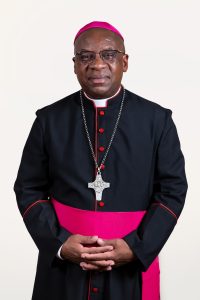
Province: Metropolitan Province of the Archdiocese of Pretoria
PATRON: Sacred Heart of Jesus. Our Lady of Good Counsel
Most Rev Archbishop DabulaMpako, Archbishop of Pretoria
Installed Archbishop of Pretoria on 22 June 2019
Auxilliary Bishop Full Name: Rt. Rev , Bishop John Masilo Selemela
Installed Auxiliary Bishop of Pretoria on- 03 September2022
Postal Address: 25 Main Street Waterkloof Pretoria 0181 / PO Box 17245, Groenkloof 0027. Jolivet House, 140 Visagie Street, Pretoria 0002
Tel: 012 326 5311
Fax: canceled
Email: archbishop@ptadiocese.org.za
Website: www.ptadiocese.org.za
Social media
Facebook
Instagram
X (formally Twitter)
Communication officer: Mathibela Sebothoma 012 326 5311 / 072 649 1799
communication@ptadiocese.org.za
Latest Biography: Archbishop Dabula Anthony Mpako was born on September 6, 1959, in Eastern Cape, within the Diocese of Umtata. He began his priestly training in 1980 at St. Augustine
Major Seminary in Lesotho and was ordained a priest on June 28, 1986, becoming incardinated in the Archdiocese of Pretoria.
On May 23, 2011, he was appointed by Pope Benedict XVI as the Bishop of the Diocese of Queenstown. Archbishop Mpako was later appointed as the Metropolitan Archbishop of Pretoria on April 30, 2019. He was installed as the 5th Archbishop of the Archdiocese of Pretoria on June 22, 2019.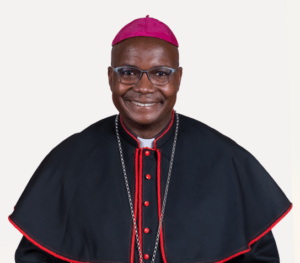
Archbishop Mpako holds a PhD in Pastoral Therapy. Biography of Bishop Masilo John Selemela Bishop Masilo John Selemela is the Auxiliary Bishop of the Metropolitan Archdiocese of Pretoria and the titular Bishop of the See of Nachingwea. Bishop Selemela was born on January 13, 1972, in Magoebaskloof, Diocese of Tzaneen.
He was ordained a priest on June 12, 1999. He holds a Licentiate and Doctorate in Dogmatic Theology. He was appointed as Auxiliary Bishop of the Archdiocese of Pretoria on June 12, 2022, and was ordained as Auxiliary Bishop on September 3, 2022.
Coat of Arms and Motto:
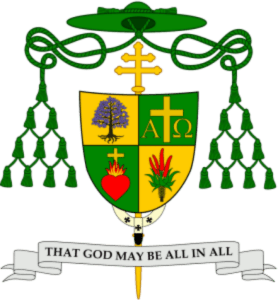
Coat of Arms and Motto of Bishop Selemela:

Predecessors:
- John Colburn Garner (January 11, 1951 – April 28, 1975, resigned)
- George Francis Daniel (April 28, 1975 – November 24, 2008, retired)
- Paul Mandla Khumalo, C.M.M. (November 24, 2008 – December 15, 2009, resigned)
- Abel Gabuza (Apostolic Administrator: December 15, 2009 – December 23, 2010)
- William Slattery, O.F.M. (December 23, 2010 – April 30, 2019)
History of the Diocese
Bishop Jolivet, OMI, Vicar Apostolic of Natal, visited this distant portion of his vast mission and celebrated the first Mass in Pretoria on June 8, 1877. Later, Lydenburg, Barberton, Pilgrim’s Rest, and the Witwatersrand were visited, and centres established. The subdivision of the Vicariate of Natal ensued, and Pretoria and surrounding districts formed part of the Prefecture Apostolic of the Transvaal in 1886, which became the Vicariate Apostolic of the Transvaal in 1904.
By a decree dated April 9, 1948, the Vicariate Apostolic of Pretoria was erected and entrusted to the secular clergy. Rt. Rev. Bishop J. C. Garner, PhD, was consecrated Titular Bishop of Tracula on May 31, 1948, and appointed the first Vicar Apostolic. On January 11, 1951, Pope Pius XII established the Ecclesiastical Hierarchy in the Union of South Africa and set up the Ecclesiastical Province of Pretoria.
Province of Pretoria
Patron: Our Lady of the Desert and St. Franc is of Assisi
Fr Gabriel Lionel Afagbegee SVD Apostolic Administrator
Postal Address:
PO Box 702, Francistown, Botswana
Residence: Bishop’s House, 364/5 Moffat Street, Francistown, Botswana.
Tel: 00267 241 0588,
Fax: 00267 241 7183.
E-mail: t.rebello@yahoo.com
Coat of Arms and Motto
Predecessors
- The Right Reverend Bishop Frank Nubuasah, SVD. Appointed Vicar Apostolic of Francistown 27th June 1998 and then Bishop on 07th November 1998. Appointed Bishop of Francistown 02nd October 2017.
- The Right Reverend Bishop Anthony Pascal Rebello SVD
Appointed Bishop of Francistown 05 July 2021, ordained Bishop on 04th September 2021. Died 04th May 2024
History of the Diocese
Created Vicariate of Francistown in 1998 with territory taken from the diocese of Gaborone that covered the whole country. It was elevated to Diocese on 2 October 2017.The territory of the Diocese lies north of the Tropic of Capricorn. The Diocese of Francistown comprises of the following civil districts: Central, North East, North West, Chobe, Ngamiland and Ghanzi.
The Diocese of Francistown is bounded to the East by the Archdiocese of Bulawayo and the diocese of Hwange (Zimbabwe), to the North by Livingstone diocese (Zambia) and the Vicariate of Rundu (Namibia), to the West by the Archdiocese of Windhoek (Namibia), to the South by the Gaborone diocese and to the South East by the diocese of Polokwane (Pietersburg) in South Africa.
More Info: Here
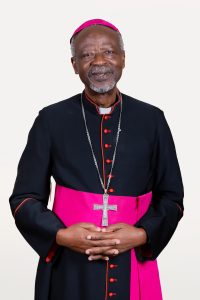 Province of Pretoria
Province of Pretoria
Patroness: Our Lady of Sorrows
Rt Rev Bishop Franklyn Nubuasah SVD, Bishop of Gaborone
Appointed Vicar Apostolic of Francistown, Botswana 27th June 1998. Ordained Bishops 07th November 1998, Appointed Apostolic Administrator of Gaborone 09th August 2017, Appointed Bishop of Francistown 02nd October 2017, Appointed Bishop of Gaborone O6th June 2019, Installed Bishop of Gaborone 17th August 2019.
Tel: 09267 395 2928 (Cathedral House)
Tel: 00 267 391 2958 (office)
Fax: 00 267 395 6970
Cell: 00267 716 13932
E-mail: nubuasah@rcc.org.bw
Postal Address:
PO Box 218, Gaborone, Botswana.
Residence: Plot 161 Queen’s road
Coat of Arms and Motto
Servus Domini
Predecessors
- Rt Rev Bishop U C J Murphy, CP, was ordained 14 September 1966 and died 27 February 1981
- Rt Rev Bishop Boniface Tshosa Setlalekgosi was Appointed Bishop of Gaborone 15th December 1981 he was ordained Bishop 6 March 1982, in Gaborone, Republic of Botswana, Southern Africa. Retired 25th April 2009
- Rt Rev Bishop Valentine Tsamma Seane was Appointed Bishop of Gaborone 05th February 2009. He was Ordained Bishop of Gaborone 25th April 2009. Resigned 09th August 2017
History of the Diocese
On 24 April 1959, Bechuanaland was constituted as a Prefecture Apostolic and confided to the care of the Passionist Congregation (St. Patrick’s Province, Ireland). On the August 1966 it became the Diocese of Gaborone.
More Info: Here
Name of Diocese: Polokwane Diocese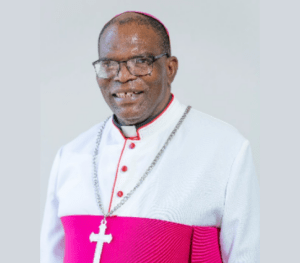
Province: Pretoria
PATRON: St. Benedict
Rev Bishop Jeremiah M Masela, Bishop of Polokwane, Diocese of Polokwane
Ordained Bishop of Polokwane on 07 September 2013
Postal Address: P.O. Box 166, Polokwane 0700 Physical Address: 55 Voortrekker St.
Tel: 015 295 8152 / 56
Fax: 015 295 8152 / 56
Email: madimetjamasela@gmail.com info@polokwanediocese.org.za / dioceseofplk@gmail.com
Website
Communication officer:
Full names: Tshianeo Elizabeth Phathela,
Contact number Tel: 015 295 8152 / 56
Email Address: info@polokwanediocese.org.za / tshianeo.phathela@gmail.com
Mobile numbers: 0822560945/ 0736616550
Latest Biography: Rt. Rev Bishop. Jeremiah Masela was born on 28 th June 1958. He began his priestly formation in 1978 at St. John Vianney Seminary in Pretoria .He was ordained as a catholic priest of the Diocese of Pietersburg on 16 th December 1984. His first appointment as a priest was at Sts. Peter & Paul Parish in Seshego (1985 – 1999) then the Sacred Heart Cathedral Parish in Polokwane (2000-2004). From 2005 to 2008 Rev. Father Masela was a formator at St. John Vianney Seminary in Pretoria; from 2009-2010 he was a parish priest at Mokopane Sts. Peter & Paul parish. He celebrated his priestly Silver Jubilee on 17 th April 2010. From 2011 to 2012 he was a parish priest of Our Lady of Good Counsel. He served as the vicar-general for both Bishop Fulgence OSB and Bishop Nkhumishe. On 09 th December 2011 Pope Benedict XVI appointed him the Apostolic Administrator of the diocese of Polokwane.
Appointment date: 10 th June 2013
Ordination date: 07 th September 2013
Coat of Arms and Motto: ( to be attached) “ Do this in Memory of me”
Coat of Arms:
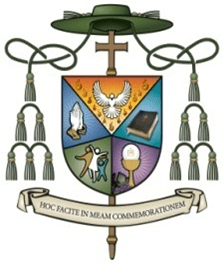
Predecessors:
1. Rt. Rev Abbot/Bishop Frederic Osterrath OSB (1939-1952)
2. Rt. Rev Abbot/Bishop F C Van Hoeck, OSB (1954-1974)
3. Rt. Rev Bishop Fulgence Le Roy OSB (1975-2000)
4. Rt. Rev. Bishop Mogale Paul Nkhumishe (2000-2011)
History of the Diocese:
The Northern Transvaal was erected a Prefecture by Decree of The Sacred Congregation for Propagation of Faith on 22 nd December 1910. The Rev Fr D Ildefons Lanslots, OSB was appointed first Prefect Apostolic. He resigned in 1921, and was succeeded by the Rt. Rev D Salvator van Nuffel, OSB, who resigned in 1939. By further decree on 13 th June 1939, the Prefecture Apostolic of the Northern Transvaal was raised to the dignity of an Abbey Nullius, followed by the Decree of 14 th November 1939 that announced the appointment by the Holy Father of the Very Rev D Frederic Osterrath, OSB, as first Abbot and Titular Bishop of Tangiers in Mauritania. He resigned in 1952. Polokwane became a Diocese on 21 st December 1988.
Province of Pretoria
Patron: St. Alphonsus Maria de Ligouri
Rt Rev Bishop Robert Mphiwe CSsR, Bishop of Rustenburg
Ordained Bishop of Rustenburg on 27 February 2021
Postal Addresss:
PO Box 45, Boshoek, 0301.
Residential Address: Bishop’s House, St Joseph’s Mission,
Boekenhoutfontein 34, Phokeng 0335.
Tel & Fax: 014 573 3403
Cell: +27 83 655 0457,
Email: bishop@diocrust.org.za, diocrust@mweb.co.za
Coat of Arms and Motto
Predecessors
- Rt Rev Kevin Patrick Dowling C.Ss.R. Appointed Bishop of Rustenburg on 02 December 1910. Ordained bishop on 27 January 1991. Retired 25 November 2020.
- Rt Rev H L Paxton Hallett C.Ss.R. Appointed Prefect Apostolic of the new Prefecture Apostolic of Rustenburg on 29 September 1971. Appointed Bishop of the new Diocese of Rustenburg on 27 November 1987, and ordained Bishop of 30 January 1988. Died on 30 January 1990, the second anniversary of his consecration.
History of the Diocese
The former Prefecture was raised to the status of a Diocese by papal decree (dated 27 November 1987).
The Diocese comprises the Magisterial Districts of Rustenburg, Koster, Swartruggens, Marico, Thabazimbi, Phokeng, Mankwe, Madikwe, Lehurutse and a portion of Odi.
Previously, the territory formed part of the Archdiocese of Pretoria.
More Info: Here
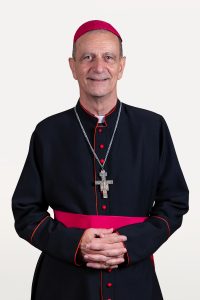 Name of Diocese: Diocese of Tzaneen
Name of Diocese: Diocese of TzaneenProvince: Pretoria
PATRONS: Our Lady of the Sacred Heart and St. Joseph
Rt Rev Bishop Joaõ Rodrigues’, Bishop of Tzaneen
Ordained Bishop of Tzaneen on 18 April 2010
Postal Address: PO Box 261, Tzaneen, Limpopo Province, 0850
Address: 40 Boundary Street
Tel: 015 307 5244.
Fax: 015 307 3078.
Email: bishopjoao@mweb.co.za
Website: Here
Social media: Facebook
Communication officer: Fr. Joseph Archibong SPS
Cell: 066 584 4278
Email: tejoe1us@yahoo.com
Latest Biography:
Joāo Noé Rodrigues was born in Cape Town, South Africa on 8 March 1955. He did his formation for the priesthood at St John Vianney Seminary in Pretoria and was ordained a priest on 4 July 1982 for the Diocese of Witbank. He served as military chaplain (1983- 1984) and as assistant priest at Sacred Heart Parish in Witbank/Emalahleni (1985-1988). He earned a Licentiate in Dogmatic Theology at the Pontifical Urban University in Rome, Italy (1988 – 1990) and was appointed as lecturer and vice rector of St John Vianney Seminary (1990 – 1993). He served as parish priest of Sacred Heart Parish in Witbank/Emalahleni (1994-1996) and as priest administrator of the Cathedral of Christ the King (1997 -2003). He also served as chaplain to the Witbank Hospital, spiritual adviser to the Sodality of the Women of St Anne, Diocesan coordinator for Catechetics and as a member of the College of Consultors for the bishop of Witbank Diocese (1994 – 2003). He earned a Master of Arts in Spirituality at the University of Santa Clara in California, USA (2003 -2005). He served again as parish priest of Sacred Heart Parish in Witbank/Emalahleni (2005-2009) until his appointment as bishop of the Diocese of Tzaneen on 28 January 2010. He was ordained bishop on 18 April 2010 and continues to serve as bishop of the Diocese of Tzaneen. Presently Bishop Joāo Rodrigues also serves in the Southern African Catholic Bishops’ Conference as chairperson of the Department for Catholic Social Action. Bishop Rodrigues speaks Portuguese, Afrikaans, English, Italian and isiZulu and also reads seSotho sa Lebowa, xiTsonga and
TshiVenda which are three major African languages spoken in the Diocese of Tzaneen.
Appointment date: 28 January 2010
Ordination date: 18 April 2010
Coat of Arms and Motto:
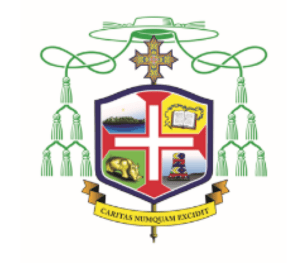
“Caritas Numquam Excidit” – “Love Never Ends” (1 Cor 13:8)
- Predecessors:
- Bishop Hugh Patrick Slattery MSC
- Bishop John T Durkin MSC Ordained 30 September 1984 Ordained 4 March 1973 Retired 28 January 2010 Died 27 September 1990
History of the Diocese:
The Diocese was originally part of the Abbey Nullius of Pietersburg. The Irish Province of the Missionaries of the Sacred Heart took responsibility for it and sent the first four Priests in 1950. This area was constituted the Prefecture Apostolic of Louis Trichardt on 29 December 1962. It was established as the Diocese of Louis Trichardt-Tzaneen by Decree of Pope Paul VI on 16 November 1972. By special Decree from Rome on 29 July 1987 the name of the Diocese was changed to that of
the Diocese of Tzaneen. The boundaries are: Zimbabwe in the North, the Dioceses of Polokwane (Pietersburg) and Emalahleni (Witbank) in the South, the Kruger National Park and Mozambique in the East, and the Diocese of Polokwane and Botswana in the West. It comprises the District Municipalities of Vhembe and Mopani, and a portion of the District Municipality of Capricorn.
More Info: Here
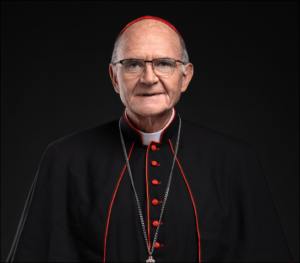
Province: Gauteng
PATRON: The Immaculate Conception
Bishop: Cardinal Archbishop Stephen Brislin, Archbishop of Cape Town
Appointed: 28 October 2024
Latest Biography:
Cardinal Stephen Brislin, Cardinal Archbishop of the Metropolitan Archdiocese of Cape Town
• Born in Welkom on 24 September 1956.
• Schooling at St Agnes’ Convent, Welkom and CBC, Welkom
• Seminary: Philosophy at St John Vianney, Pretoria and Theology at the Missionary Institute, London
• Ordained a priest on 19 November 1983.
• Ordained Bishop of Kroonstad on 28 January 2007.
• Installed as Archbishop of Cape Town on 7 February 2010, on the Solemnity of Our Lady of the Flight into Egypt, the patronal
feast of the Archdiocese of Cape Town.
• Awarded an Honorary Doctorate of Pastoral Leadership by the Oblate School of Theology, San Antonio, Texas, USA on 5 May
2023.
• Announced as a Cardinal by Pope Francis at the pope’s Angelus address in Rome on 9 July 2023.
• Created a Cardinal-Priest of the Titular Church of Santa Maria Domenica Mazzarello by Pope Francis at the Consistory on 30
September 2023.
Postal Address:Private Bag x 10, Doornfontein, 2028
Tel:011 402 6400
Email: chancellor@catholicjhb.org.za
Website
Social media:Archdiocesan News Jhb
Communication Department/Adnews Office: 0114026400,
communications@catholicjhb.org.za or adnews@catholicjhb.org.za
Latest Biography: His Grace was appointed Archbishop of Bloemfontein on 13 January 1999 and ordained and installed Archbishop of Bloemfontein on 10 April 1999. He was transferred to the Diocese of Johannesburg on 8th April 2003, with the title Archbishop-Bishop of Johannesburg. He was installed as Bishop of Johannesburg on the 29th of June 2003, at Ellis Park Rugby Stadium. On the 5th of June 2007, when the Diocese of Johannesburg became an Archdiocese, he was appointed the First Archbishop of the Archdiocese of Johannesburg.
• He matriculated at Inchanga High School, near Pietermaritzburg, KwaZulu-Natal
• In 1967 he entered the novitiate of the Oblates of Mary Immaculate at Villa Maria, Quthing, Lesotho.
• In 1968 he entered the Mater Jesu Scholasticate in Roma in Lesotho, where he obtained a BA Degree.
• He studied Theology at the Gregorian University in Rome between 1972 and 1976
• He was ordained to the Priesthood by Archbishop Fanyana Butelezi OMI in 1976 and worked in the Soweto community, servicing at Our Lady of Fatima in Dube,1979 – 1984, Our Lady of Mercy in Emdeni, 1984 – 1989, Christ the King in Orlando East, 1989 – 1999.
• Archbishop Buti Tlhagale OMI has been a visiting lecturer at St Joseph’s Theological Institute in Cedara, KwaZulu-Natal. He taught philosophy at St Peter’s Major Seminary in Hammanskraal and has written extensively on Theology, Inculturation and Labour matters.
• He worked in the Justice and Peace Department of the South African Council of Churches in 1979 – 1980.
• He served as Secretary General of the Southern African Catholic Bishops’ Conference (SACBC), 1995 – 1999.
• He was ordained Archbishop of Bloemfontein in 1999 and appointed Bishop of Johannesburg in 2003.
• He was Grand Chancellor of St Augustine College of South Africa, the Catholic University in Victory Park, Johannesburg.
• On June 5, 2007, The Holy Father, Pope Benedict XVI, raised the Diocese of Johannesburg to the status of a Metropolitan Archdiocese and appointed the Most Reverend Buti Joseph Tlhagale, OMI, as its first Metropolitan Archbishop.
Appointment date: Appointed Archbishop of Bloemfontein on 13 January 1999. He was installed as Bishop of Johannesburg on 29 June 2003, with the title Archbishop-Bishop of Johannesburg. On 5 June 2007, when the Diocese of Johannesburg became an Archdiocese, he was appointed the first Archbishop of the Archdiocese of Johannesburg.
Ordination date: 10 April 1999 as Archbishop of Bloemfontein
Coat of Arms and Motto: Called to serve
Predecessors:
- Auxiliary Bishop/ Bishop Reginald Orsmond Diocese of Johannesburg 1983 – 2002
- Archbishop Joseph Fitzgerald OMI – Bishop of Johannesburg 1976 – 1983
- Archbishop Peter Fanyana Butelezi OMI Auxiliary Bishop of Johannesburg 1972 – 1975
- Bishop Hugh Boyle 1954 – 1976 Bishop of Johannesburg
- Bishop William Patrick Whelan OMI Bishop of Johannesburg
- Bishop David O’Leary OMI 1925 – 1958 Vicar Apostolic of the Transvaal
- Bishop Charles Cox OMI 1914 – 1924 Vicar Apostolic of the Transvaal
- Bishop William Miller OMI 1904 – 1912 Vicar Apostolic of the Transvaal
- Bishop Charles Jolivet OMI 1874 – 1903 Vicar Apostolic of Natal
- Bishop JF Allard OMI 1850 Vicar Apostolic of Natal
History of the Diocese:
Discovery of gold and early Johannesburg churches. The history of the archdiocese of Johannesburg begins with the discovery of gold. In 1886 gold was discovered on the farm ‘Langlaagte’ and soon after President Kruger declared the fields a “public digging”. The immediate effect of this was the arrival of hundreds and then thousands of prospectors who came to seek their fortunes. Almost overnight, a vast tented camp sprung up, known as Ferreira’s Camp. As the population increased, visits were made by Oblate priests from Pretoria and arrangements were made to say Mass for the Catholics among the prospectors. On 20 th February 1887 Fr Leopold Trabaud recorded in his diary: “I said the first Mass that has ever been celebrated on this plateau, open veld up to the present. A reed hut, the bakery of the camp, is put at my disposal by Mr Whelan of Bloemfontein. There were thirty-three Catholics present.” The exact site of this first Mass is lost to us, but it took place somewhere to the west of the present-day City Hall building, now occupied by the Gauteng Provincial Legislature. A few months after the first Mass was said, Fr Monginoux travelled from Pretoria to take up residence on the goldfields. His diary entry noted: “the town they are building is to be called Johannesburg.” Early conditions continued to be primitive, and subsequent Masses were said in a variety of different places, one Sunday a storeroom, the next a stable. However, the tented camp progressed very quickly into an orderly city with buildings made of wood and iron. Thanks to the generosity of the miners, Fr Monginoux was able to procure land and build the first Catholic church in Johannesburg. He acquired a stand on the corner of Fox and Small streets and in August 1887 a small church with a three roomed dwelling for the priest on one side and a temporary convent and school room adjoining was opened. Fr Stephen Hammer OMI was appointed the first parish priest. The neighborhood around this site was still bare veld. Very soon these buildings proved inadequate, and the decision was taken to allow the first church building to be taken over completely by the school and to build a new church. Land was acquired on the corner of Main and von Wielligh streets and the new church was opened in 1891.
FOX STREET CATHOLIC CHURCH:
Fr Monginoux had foreseen that an even larger church would be required soon and identified the block bounded by Kerk, Gold, President and Nugget streets as the ideal site. However, financial constraints made the purchase of the site impossible. The story is told that he took a medal of Our Lady of the Immaculate Conception from his pocket, prayed and buried it in the soil on this site, believing that only a miracle would enable him to buy it. In 1892, Fr Aloysius Schoch OMI replaced Fr Monginoux as Prefect Apostolic. One of his first duties was the choice of a new and larger site for a church. The entire block containing the second church was purchased by Castle Breweries and, providentially, Fr Schoch thus had the means to acquire the very site on Kerk Street which had been identified by Fr Monginoux. It was here that a magnificent church and presbytery was built and opened in 1895. This church, always referred to as the Pro-Cathedral, is the mother church of Johannesburg. The Pro Cathedral would feature prominently in Catholic city life for nearly sixty years until it was eventually demolished.
Importance of schools
Mission schools, and to a lesser extent hospitals, became the principal means of establishing missions in South Africa in the nineteenth century. Bishop Jolivet was a great proponent of educating youth and his priority was the establishment of schools. In this, he showed great vision and wherever a church was built, a school was sure to follow. Staffed by communities of religious teaching sisters and supported by both Catholic and non-Catholic laity who were prepared to pay fees, schools proved to be a material means of supporting missions as well as breaking down anti-Catholic prejudice. As well as providing a solid Catholic education, Catholic schools were able to demonstrate and maintain a Catholic presence during a largely Protestant population. The first Catholic schools in Johannesburg were established at the same time as the churches. The first school was opened in 1887 by the Holy Family Sisters, followed in 1889 by a Marist Brothers school in Koch Street.
The Transvaal Vicariate
In 1904 the decision was taken to erect the Transvaal into a Vicariate and Bishop William Miller OMI was appointed first Vicar Apostolic. His Vicariate was still impossibly large, under-developed and there was a shortage of priests. The result was an inability to open new missions and staffing of existing parishes was proving troublesome. The Bishop’s greatest problem, however, was dealing with the financial crisis which had arisen due to imprudent property acquisitions. Worn out by the effort required to service the debts for which he had not been responsible, Bishop Miller decided to resign in 1912. The new Vicar Apostolic, Bishop Charles Cox OMI, was an experienced administrator with a background in accountancy. By cutting expenditure and planning with extreme care, he was able to put the Vicariate onto a sound financial footing. Another task that Bishop Cox needed to address was the lack of progress in evangelising the black population.
Black migrant workers had begun arriving in the Witwatersrand searching for work as early as the 1890s, but Catholic mission activity amongst them had been slow. The church’s position at this time was to seek out and administer to the needs of the existing Catholic population. The axiom being followed was “first those of the household of the Faith”. When Bishop Charles Cox assumed administration of the Vicariate, the only active mission work among blacks in Johannesburg was in the Doornfontein area. This had extended to the nearby gold mines of Village Deep, City Deep and Crown Mines and in 1918 the mission in Alexandra township had been founded. There was concern that not enough was being done to train black priests and catechists and there was criticism about the small number of black converts. Bishop Charles Cox,14 however, was still hamstrung by the financial position of the Vicariate and was reluctant to take on any new projects until the debt situation had improved.
In 1925, Bishop David O’Leary OMI was appointed third Vicar Apostolic of the Transvaal Vicariate. He inherited an administration where the debts had been greatly reduced and the beginnings of black missionary work had been made. It was largely due to his own determination and drive that remarkable missionary progress was made during his Vicariate. During his twenty-five years as Bishop, thirty-two churches or missions for blacks were opened and thirteen parishes for whites. In addition, it was during Bishop O’Leary’s time that the concepts of Social Catholicism, Catholic Action, the role of the laity and attitudes towards the working classes were first introduced into Catholic parish life.
The new hierarchy
In 1951, the Pope Pius XII established the hierarchy in South Africa, thereby putting his seal of approval on the achievements of the church in this country. Under the new hierarchy, Johannesburg became a Diocese and Bishop William Patrick Whelan OMI was appointed the first bishop. His tenure only lasted three years and in 1954, he was replaced by Bishop Hugh Boyle. Johannesburg was now a Diocese administered by a Diocesan Bishop.
The years of crisis
In 1948, the Nationalist Government was voted into power and the political situation became a cause of concern for all Christian churches. Within a short space of time, the government began to pass discriminatory legislation to entrench their Policy of Separate Development. The Group Areas Act of 1950 meant the closure of some churches and schools as black communities were resettled with the resultant need to establish churches and schools in the new localities. The Homelands Policy had a similar effect with the transfer and resettlement of people requiring the enlargement of existing facilities or the building of new ones. The law which was to have the most far-reaching consequences on the Catholic mission was the Bantu Education Act of 1953. The Catholic church in South Africa had based its whole mission method on the Catholic school’s system, and this legislation was a serious attack on the structure. When subsidies for mission schools were withdrawn, the Catholic church launched a fund to keep the schools open and enormous sums were raised. Despite these heroic efforts, it could only ever be a temporary solution, and eventually most black primary schools were handed over to the government and available funds were used to keep some of the secondary schools open. Despite these tremendous challenges, during the twenty-two years that Bishop Hugh Boyle was bishop, fourteen parishes were blessed, and forty black parishes established, most of them in new areas created due to apartheid policies. The newly located people were in no position to contribute to the building of new churches and schools and appeals had to be made to overseas benefactors. It was also during Bishop Boyle’s tenure that the longed-for dream of a Cathedral was finally achieved when the Cathedral of Christ the King was opened in 1960.
Bishop Boyle did not only have to contend with the political situation in South Africa. During his episcopate the Second Vatican Council took place (1962-1965) and the decisions taken there set in motion a tidal wave of change within the church. The disappearance of much that was old and familiar caused distress to both clergy and laity alike. Educating and informing the cleric and lay person about the transformation of parish structures and the transformation of the rite of Mass took time and effort. In 1972, Bishop Peter Butelezi was appointed Auxiliary to Bishop Boyle but he was translated to the See of Umtata three years later. Bishop Boyle resigned in 1976 and Archbishop Joseph Patrick Fitzgerald was appointed as Bishop of Johannesburg. His title was from the time when he was Archbishop of Bloemfontein, and the Pope gave him permission to continue using it
on his appointment as Johannesburg’s Bishop. During 1970s and 1980s, spurred by protests from black clergy, Catholic opposition to apartheid started to intensify. The Soweto uprising of 1976 led to more awareness of the political situation and Catholics began to participate actively in Christian protest. In 1983, Archbishop Fitzgerald resigned, and it was left to Bishop Reginald Orsmond to guide the diocese through the last years of apartheid rule and the early years of the first democratically elected government in 1994.
The establishment of the Archdiocese of Johannesburg
In 2003, Archbishop-Bishop Buti Tlhagale was installed as Bishop of Johannesburg and on 5 June 2007, when the Diocese became an Archdiocese, he was appointed the first Archbishop of the Archdiocese of Johannesburg. Despite its late arrival on the missionary scene, the Catholic church has shown remarkable signs of growth in the twentieth century. Long seen as a foreign church, it has now gained influence in all sectors of society. At least 8% of the South African population is Catholic and about 80% of its members are Black. In the Archdiocese of Johannesburg today the Catholic population is 918 456 out of a total population of 9 220 00016.
More Info: Here
Province of Johannesburg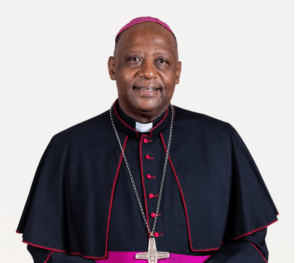
Name of Diocese: DIOCESE OF KLERKSDORP
PATRON: SAINTS PETER AND PAUL
Rt Rev Bishop Victor Tlholo Phalana, Bishop of Klerksdorp
Ordained Bishop of Klerksdorp on 25 January 2015
Postal Address: P.O. BOX 3071, FREEMANVILLE 2573
Address: 5 Poppy Avenue Adamayview
Tel: +27 18 462 2261
Fax: +27 86 295 4000
Email: reception@dioceseofklerksdorp.com
Website: dioceseofklerksdorp.co.za
Communication officer: Rev. Fr. Izuchukwu Joachim Anakwenze
Contact details: +27603037677
Email: izuchukwuanakwenze@gmail.com
Latest Biography:
Bishop Victor Hlolo Phalana was born on 3 April 1961 in Erasmus, Odi, North West Province, South Africa. He was raised by his mother’s uncle: Clovis Phalana and Victoria Phalana. They were full time catechists and teachers in Catholic Schools. His adoptive parents received Papal Medals: Bene Merenti and Cross Pro Ecclesia et Pontifice respectively. Both of them collaborated in introducing the Sodality and of the Sacred Heart and the Sodality of St Anne to the Archdiocese of Pretoria. Victor did his primary school studies at Sjambok School in Eramsus under Mr Michael Tshetlo. He completed his Matric studies at Tsogo High School under the Mercy Sisters. The principal was Sister Majella Quinn, in Mmakau, Dewildt. He was an altar server under Fr Guiliano Melotto CSS, a Stigmatine. He attended the Vocational Centre in Mmakau under Fr Michael D’Annucci, who also became his chaplain and mentor in the Chiro Movement of South Africa. May he Rest in Peace! He started his seminary formation in Hammanskraal, St Peter’s Orientation – under Fr Sebastian Mahara. He studied philosophy and theology at the major seminary of St John Vianney in Pretoria, under Fr Myles Russell OFM and Fr William Slattery OFM. He was ordained to the priesthood on the 14th May 1988 in Medunsa, by Archbishop Emeritus, G.F. Daniel where he was also incardinated to the Archdiocese of Pretoria. Following his ordination, Father Phalana served as parochial vicar of St. Camillus in Hammanskraal (1988-1989) and later as Pastor of Christ the King, Mabopane (1989-1992). From 1992-1993 he was Professor at the Propaedeutic Seminary of Hammanskraal and Cape Town. He received his Licentiate in Spiritual Theology from the Pontifical Gregorian University in Rome in 1995. In 1999 he undertook studies in African Culture at the Catholic University of Eastern Africa in Nairobi.
His Lordship, Bishop Victor, known to many as ‘bro V’ or ’Mavee’, has been a Catholic priest for 27 years. He was ordained for the Archdiocese of Pretoria as a Diocesan Priest, where he served as a Vicar General to Archbishop William Slattery, OFM. He has spent his ministry working in Pretoria, Cape Town and Germiston.
His Lordship Bishop Victor has served the church in various capacities: Parish Priest, Chaplain of the Chiro Youth Movement, Vicar for Evangelisation, Vocations Director and Dean of the North West Deanery. Fr Victor served as a formator at St Paul’s Orientation Seminary in Hammanskraal; St Francis Xavier Orientation Seminary in Cape Town; St Peter’s Philosophicate in Garsfontein (Tshwane); and also in his Alma Mater, St John Vianney Seminary in Waterkloof (Tshwane). He was also a workshop facilitator/trainer on behalf of Lumko Institute in Germiston.
As a facilitator he had to visit every corner of the Republic of South Africa. He did some ministry in Mozambique, Zimbabwe, Ethiopia, South Sudan, Italy, Lugano in Switzerland and Zambia.
He served as Secretary of the Southern African Council of Priests (SACOP).
He served on various committees of the Southern African Bishops Conference: Committee of Liturgy and Inculturation; Committee of Ecumenism and Inter-Religious Dialogue; Committee for Culture.
He was Chairperson of the Board of the Oukasie Development Trust; Deputy Chairperson of the Tshwane Leadership Foundation and a Board member of Yeast Housing in Tshwane.
He continues to be involved in community projects. One of those community based projects, Hectorex, is presently promoting IT training and IT networking; Maths and Science Training for Educators and High School students; Science Week and Girl Learner Training. These projects are based in the Madibeng Municipality, Oukasie and Hartebeespoort.
Bishop Victor is passionate about South Africa. He would like to see our South African story being a success story; not a story of disastrous failure! He is concerned about all those who criticise without putting forward possible solutions to the challenges facing us. He believes that co-operation and collaboration are the best tools for success and development. He, like most of us, would like to be a part of the solution, not part of whiners and reactionaries.
He was ordained bishop of Klerksdorp on the 25th of January 2015 by Archbishop William Slattery, OFM. His Motto is “JESUS CHRIST IS LORD!”
Appointment date: 24TH NOVEMBER, 2014
Ordination date: 25TH JANUARY, 2015
Coat of Arms and Motto:
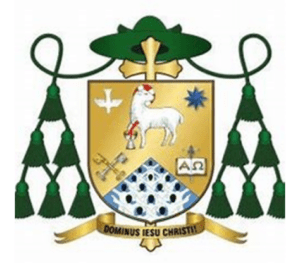 Jesus Christ is Lord
Jesus Christ is Lord
Predecessors:
- RT. REV. DANIEL A.O. VERSTRAETE, OMI
- REV. ZITHULELE PATRICK MVEMVE
History of the Diocese
The former Prefecture of the Western Transvaal, established by the decree of Pope Paul VI on the 14th October 1965, was raised to the status of Diocese of Klerksdorp by papal decree dated 27th February 1978.
Originally part of the Diocese of Johannesburg, the Diocese of Klerksdorp is bound on the East by the Archdiocese of Johannesburg, on the South by the Kroonstad Diocese and Bloemfontein Archdiocese, on the West by the Kimberley Diocese and on the North by the Diocese of Rustenburg.
The Diocese comprises the following civil districts: Potchefstroom, Klerksdorp, Hartbeesfontein, Wolmaransstad, Bloemhof, Christiana, Schweizer-Reneke, Delareyville, Lichtenburg, Coligny and Ventersdorp.
PASTORAL AREAS
To ease the work and facilitate effective service delivery to the entire Catholic Community, the Diocese of Klerksdorp is divided into four deaneries which are Saint Francis of Assisi Deanery, Blessed Benedict Daswa Deanery, Saint Eugene de Mazenod Deanery and Divine Mercy Deanery.
The Diocese has a geographic area of 34 800 square Km. It has a population estimated to date at 1 500 000 people and a Catholic population of 99 232 Hab.
The Diocesan feast day falls on 29th June and its patron saints are Saints Peter and Paul.
PREDECESSORS
The Right Reverend Bishop Daniel A. O. Verstraete OMI, appointed Prefect Apostolic 9th November 1965 and then Bishop 27th January 1978. He was ordained on 14th May 1978 at Klerksdorp. He resigned due to ill health.
The Right Reverend Bishop Zithulele Patrick Mvemve, ordained Bishop of the Titular See of Luperciana 29th June 1986 at Johannesburg. Appointed Auxiliary and Vicar General to Bishop Orsmond. Appointed Bishop of Klerksdorp 10th May 1994. He resigned 26th April 2013.
The Most Reverend Archbishop Buti Thagale OMI, Metropolitan Archbishop of Johannesburg was appointed Apostolic Administrator of the Diocese of Klerksdorp on 26th April 2013.
More Info: Here
Province of Johannesburg
Patron: St Joseph
Rt Rev Bishop José Luis Ponce de León IMC – Bishop of Manzini – Swaziland
Installed Bishop of Manzini on 26 January 2014
Appointed Apostolic Administrator: 29 August 2012, Appointed Bishop of Manzini: 29 November 2013
Installed Bishop of the Diocese: 26 January 2014
Postal Address: Sandlane Street / PO Box 19, Manzini Swaziland.
Tel: 002682 505 2348,
Fax: 00 268 505 4876
Email: chancery@dioceseofmanzini.org
Coat of Arms and Motto
Livi Laba Yinyama
Predecessors
- Rt Rev Msgr P. M. Bellezze OSM was appointed 27 April 1923 and resigned May 1933. He was followed by Rt Rev Msgr R.M. Migliorini OSM and was appointed 8 July 1933.
- Rt Rev Bishop A.C.M. Barneschi OSM, OBE was appointed 15 March 1939, consecrated Titular Bishop of Thagaste on 30 April 1939 and enthroned Bishop of Bremersdorp(later Manzini) on 15 August 1951. Nominated Assistant at the Papal Throne, 11 May 1964, he died 21 May 1965 at Manzini.
- Rt Rev Bishop Jerome Rio Maria Casalini, OSM, was appointed 18 December 1965 and ordained 12 February 1966. He resigned 29 January 1976 and died 28 August 1982.
- Rt Rev Bishop Aloysius Mandlenkhosi Isaac Zwane, appointed 29 January 1976, was ordained 16 May 1976. He died 9 August 1980.
- Rt Rev Louis Ncamiso Ndlovu, OSM, was appointed Apostolic Administrator 20 February 1981 and appointed Bishop of Manzini 31 July 1985. He was ordained Bishop of Manzini 12 October 1985 and died 27 August 2012.
History of the Diocese
The Swaziland Mission was confided the Order of the Servants of Mary (OSM), by the Sacred Congregation for the Propagation of Faith on 4 April 1913. On 19 April 1923, it was separated from the Natal Vicariate and constituted the Prefecture Apostolic of Swaziland. On the 15th March 1939, it was elevated to the rank of Vicariate Apostolic. On the 11th January 1951, it became the Diocese of Bremersdorp, the name of the town later being changed to Manzini. The Diocese comprises the Kingdom of Swaziland.
More Info: Here
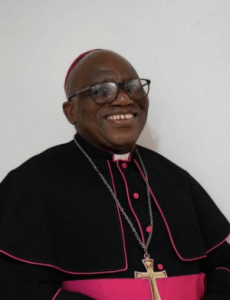 Name of Diocese: Witbank
Name of Diocese: Witbank
Province: Mpumlanga
PATRON: St. Peter Claver & St. Therese of the Child Jesus
Rt Rev Bishop Xolelo Thaddaeus Kumalo, Bishop of Witbank
Installed Bishop of Witbank on 20 March 2021
Postal Address: PO Box 651 – Witbank 1035
13 Elizabeth Ave
Tel: 013 656 6827
Fax: 086 685 5176
Email: admin@dioceseofemalahleni.org
Social media: Facebook
Communication officer: Kgomotso Direro
Mobile Number: 082 051 7320
Email: admin@dioceseofemalahleni.org
Latest Biography:
Bishop Kumalo was born on 2 July 1954 in Gogele in the Diocese of Kokstad, South Africa. He finished high school at St. Paul’s Minor Seminary in Hammanskraal. In 1976 he became a Franciscan postulant and in 1979 entered the Novitiate. After a year of philosophy studies at the Franciscan Study Centre in Wingate Park, he left the order of his own accord and was sent by the Bishop of Witbank to St. John Vianney National Seminary (affiliated with the Pontifical Urbaniana University) to continue his studies.
He was ordained a Deacon for the Diocese of Witbank in 1985. After some years working as a clerk in a steel factory, the Bishop of Bethlehem accepted him into his Diocese. As a Deacon he was sent to study at Boston College in the United States. Upon his return home, he was ordained a priest in 1991 and incardinated in the Diocese of Bethlehem. After ordination, he served as a Parochial vicar from 1991 to 1993 and then as a Pastor until 1996, after which he served as Episcopal Vicar for Catechists from 1995 to 1995, Pastor and head of the John Paul II Formation Centre from 1996 to 1999, Vicar General from 2000 to 2006 and Financial Administrator of the Diocese of Bethlehem since 2007. He has been appointed Bishop of Eshowe on the 11 March 2008 and ordained bishop on the 7 June 2008. He was appointed the Bishop of Witbank on the 25 th November 2020 and installed 20 March 2021.
Appointment date: 25 November 2020
Ordination date: 07 June 2008
Coat of Arms and Motto:
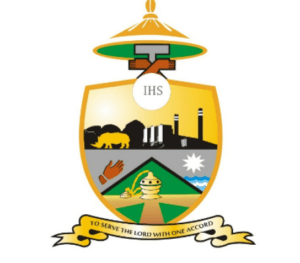
To Serve the Lord with one Accord
Predecessors:
- Prefect Apostolic Daniel Kauczor MFSC: 19231926
- Prefect Apostolic Aloysius Mohn MFSC: 19261939
- Bishop Johannes Riegler MFSC: 19391955
- Bishop Anton Reiterer MCCJ: 19561983
- Bishop Mogale Paul Nkhumishe: 19832000
- Bishop Paul Mandla Khumalo CMM: 2002 – 2009
- Bishop Giuseppe Sandri MCCJ: 2010 – 2019
History of the Diocese
By Papal Decree 12 June 1923, the Eastern Transvaal (Mpumalanga) was separated from the Transvaal Vicariate and entrusted to Missionaries, Sons of the Sacred Heart (MSFC). In 1979 the MFSC rejoined the Verona Fathers (FSCJ) and are now known as the Comboni Missionaries of the Heart of Jesus (MCCJ).
The Lydenburg Prefecture was raised to the status of a Vicariate on 9 December 1948. Following the establishment of the hierarchy in South Africa, the Vicariate was raised to the status of a diocese on 11 January 1951. On the 23 June 1958, a number of magisterial districts on the southern boundary of the diocese were excised and incorporated in the Volksrust Prefecture. On the 13 September 1964 the name of the diocese changed to Lydenburg Witbank by papal decree and on the 10 November 1988 to Witbank.
The diocese comprises the magisterial districts of Barberton, Belfast, Carolina, Kamhlushwa, Lydenburg, Mapulaneng, Mhala, Middelburg, Nebo, Nelspruit, Nsikazi, Pilgrims Rest, Sekhukhune, WatervalBoven, White River, Witbank, and portions of
Eerstehoek and Groblersdal. Some of these districts are located in the province of Mpumlanga, others in Limpopo.
More Info: Here
Province of Durban
Patrones: Our Lady of the Immaculate Conception
Most Rev Archbishop Siegfried Mandla Jwara CMM, Archbishop of Durban
Installed Archbishop of on 08 August 2021
Rt. Rev Bishop Elias Kwenzakufani Zondi, Auxiliary Bishop of Durban
Ordained Auxiliary Bishop of Durban on 27 May 2023
Postal Adress:/ Address: 154 Gordon Road Durban 4001 / PO Box 47489, Greyville 4023.
Tel: 031 303 1417.
Fax: 031 312 1848
Coat of Arms and Motto
Predecessors
- Rt Rev Marie Jean Francois Allard OMI, Titular Bishop of Samaria and Vicar Apostolic of Natal, ordained 13 July 1851 at Marseilles by the Blessed Charles Joseph Eugene de Mazenod, Founder of the Congregation of the Oblates of Mary Immaculate; retired in 1873; appointed Archbishop of Taron in partibus; died in Rome in 1889.
- Rt Rev Charles Constant Jolivet OMI, Titular Bishop of Bellina and Vicar Apostolic of Natal, appointed 15 August 1874, ordained November 1874; died at Durban 15 September 1903.
- Rt Rev Henry Delalle OMI, Titular Bishop of Thugga and Vicar Apostolic of Natal; appointed 19 December 1903, ordained 2 June 1904; retired 4 April 1946; died at Durban 15
February 1949. - Most Rev Denis Eugene Hurley OMI, Titular Bishop of Turuzi and Vicar Apostolic of Natal, 12
December 1946, ordained 19 March 1947; became Archbishop of Durban 11 January 1951; retired June 1992; died at Durban 13 February 2004. - Rt Rev Bishop Dominic Joseph Chwane Khumalo OMI, Titular Bishop of Buxentum and was ordained Auxiliary Bishop of Durban on 04 May 1978. Died 27 April 2006.
- His Eminence Wilfrid Fox Cardinal Napier OFM; appointed Archbishop of Durban 29 March 1992; retired 07 June 2021.
History of the Diocese
This territory was erected as the Vicariate of Natal on 5 October 1850, extending “from the Kei River, that is, from the boundary of the Eastern Vicariate of the Cape of Good Hope, to Quilimane, that is, the Eastern extremity of Portuguese territory, and interiorly to the Tropic”. It was confided to the Oblates of Mary Immaculate.
The vague delimitation of boundaries prompted many queries on the part of the first Vicar Apostolic, Bishop Allard, who finally interpreted them as extending northwards as far as the tropic of Capricorn and excluding Portuguese territory. On 15 March 1876 a clarification was issued to Bishop Jolivet establishing the boundaries of the Natal Vicariate as following the line of the coast from the Kei River to Quilimane, then along the 18th degree of latitude south, down the 18th degree of longitude east, and finally along the course of the Orange River and the frontier of the Cape Colony, leaving British Kafraria in the Eastern Vicariate.
This huge territory was divided soon afterwards when the Zambesi Mission was confided to the Society of Jesus in 1879. There followed in 1886 the erection of the Vicariate of the Orange Free State (comprising the Free State, Basutoland and the Diamond Fields); and the Prefecture of the Transvaal. In 1921 further divisions were made with the creation of the Vicariates Apostolic of Mariannhill, Eshowe, and Swaziland.
On the establishment of the Hierarchy on 11 January 1951 the Vicariate Apostolic of Natal became the Archdiocese of Durban. In 1958 the northern section of the Archdiocese was detached to form part of the Prefecture Apostolic of Volkrust, now the Diocese of Dundee.
The Archdiocese of Durban comprises the civil districts of Camperdown, north of the Umlaas River, (except the farms of Mariannhill, Klaarwater, Dassenhoek, Welbedag and portion of Stockville), Durban, Estcourt, Inanda, Kranskop, Lions River, Lower Tugela, Maphumulo, Umvoti, Weenen, Bergville and part of Msinga.
More Info: Here
Province of Durban
Patron: Our Lady of Lourdes
Rt Rev Bishop Stanislaw Jan Dziuba, o.s.p.p.e, Bishop of Umzimkulu
Ordained Bishop of UMzimkhulu on 14 March 2009
Postal Address:
Diocese of Umzimkulu, Ballance Street / PO Box 250, Harding 4680
Residence: 19 Ballance Street, Harding
Tel: 039 433 1421
Fax: 039 433 1241
E-mail: stanley.dziuba@gmail.com / bishopsoffice@telkomsa.net
Coat of Arms and Motto
In Servitio Populi Dei
Predecessors
- Rt. Rev Pius Bonaventure Dlamini FFJ ordained on 26 April 1954.
- Very Rev Msgr. Peter J Butelezi, OMI was appointed Apostolic Administrator on 8 January 1968
- Most Rev Denis E Hurley OMI, Archbishop of Durban was appointed Apostolic Administrator on 11 September 1972.
- Rt. Rev Sithunywa Gerard Ndlovu was appointed second Bishop of Umzimkulu on 22 December 1986. He was ordained and canonically installed on 25 April 1987. He resigned in August 1994.
- H.E. Wilfrid Cardinal F Napier OFM, appointed Apostolic Administrator on 1 August 1994 and took possession on 21 September 1994 until March 2009.
History of the Diocese
The Diocese of Umzimkulu was established in 1954 by the excision from the Diocese of Mariannhill, of the civil districts of Umzimkulu, Harding and portions of the districts of Port Shepstone, Bulwer and Himeville, south of the Umzimkulu River.
More Info: Here
Eshowe
Province of Durban
Patron: St. Benedict
His Cardinal Emeritus Wilfrid Fox Napier OFM, Apostolic Administrator of Eshowe Diocese
Appointed as Cardinal on 21 February 2001
Postal Address:
Private Bag 553, Eshowe 3815
Residence: 02 Binns Avenue
Tel: 035 474 1243
Fax: 035 474 4644,
E-mail: bishop@eshowe.org
Coat of Arms and Motto
To serve the Lord with one accord
Predecessors
- Rt Rev Bishop Thomas Spreiter, OSB, Titular Bishop of Thaenae. Consecrated 1 May 1906 as second Vicar Apostolic of Dar-es-Salaam; Prefect Apostolic of Zululand 27 August 1921; first Vicar Apostolic of Eshowe 11 December 1923; resigned 14 May 1943, died 27 January 1944 at Inkamana.
- V. Rev Theodos Schall OSB, Administrator Apostolic from 14 May 1943 to 3 August 1947.
- Rt Rev Bishop Aurelian Bilgeri OSB, appointed 12 June 1947. Consecrated Titular Bishop of Germanicopolos and second Vicar Apostolic of Eshowe 14 September 1947. First
Bishop of Eshowe 11 January 1951. Died 24 July 1973 at Mtunzini. - Rt Rev Bishop Mansuet Dela Biyase, appointed Bishop on 28th February 1975. He was ordained Bishop on 28 June 1975. He died on 1 July 2005.
- Rt Rev Bishop Xolelo Thaddaeus Kumalo, appointed Bishop on 11 March 2008. Ordained Bishop 7 June 2008. Appointed Bishop of Witbank on 25 November 2020.
History of the Diocese
The Prefecture of Zululand was erected on the 27 August 1921 and entrusted to the Benedictine Congregation of St Ottilien. Before that time it had formed part of Natal Vicariate. On 11 December 1923 it was raised to the status of a Vicariate under the title of “Vicariate Apostolic of Eshowe”. With the establishment of the Hierarchy in South Africa it became the Diocese of Eshowe on the 11 January 1951. This Diocese now comprises Zululand proper, (with the exception of the districts of Ingwavuma, Ubombo and Hlabisa), and the four Natal districts of Vryheid, Paulpietersburg, Ngotshe and Babanango. It is bound on the East by the Indian Ocean, on the South by the Tugela River, on the West by the Tugela, Buffalo, Blood and Didusini Rivers, and in the North by the Pongola and Umfolozi Rivers.
More Info: Here
Province of Durban
Patrons: The Good Shepherd, Our Lady of Sorrows
Rt. Rev. Bishop Vusimusi Mazibuko OMI , Bishop of Ingwavuma
Ordained Bishop of Ingwavuma on 03 June 2023
Postal Address: PO Box 23, Mtubatuba 3935
Residence: Lot 51 Riverview Catholic Mission Mtubatuba
Tel: 035 550 1051,
Tel & Fax: 035 550 1062 (Mtubatuba office)
Tel & Fax: 035 838 1136 (Hlabisa office)
Fax: 086 608 8899
E-mail: vicariatemtuba@gmail.com
Coat of Arms and Motto
The truth will set you free
Predecessors
- Rt Rev Bishop Thomas Spreiter, OSB, Titular Bishop of Thaenae. Consecrated 1 May 1906 as second Vicar Apostolic of Dar-es-Salaam; Prefect Apostolic of Zululand 27 August 1921; first Vicar Apostolic of Eshowe 11 December 1923; resigned 14 May 1943, died 27 January 1944 at Inkamana.
- V. Rev Theodos Schall OSB, Administrator Apostolic from 14 May 1943 to 3 August 1947.
- Rt Rev Bishop Aurelian Bilgeri OSB, appointed 12 June 1947. Consecrated Titular Bishop of Germanicopolos and second Vicar Apostolic of Eshowe 14 September 1947. First
Bishop of Eshowe 11 January 1951. Died 24 July 1973 at Mtunzini. - Rt Rev Bishop Mansuet Dela Biyase, appointed Bishop on 28th February 1975. He was ordained Bishop on 28 June 1975. He died on 1 July 2005.
- Rt Rev Bishop Siegfried Mandla Jwara C.M.M, appointed Bishop on 30 April 2016, ordained Bishop 25 June 2016, Appointed Archbishop of Durban 09 June 2021.
History of the Diocese
The Prefecture was erected by the Bull “Quoniam Praecipuas” dated 12 November 1962 and entrusted to the United States of America Eastern Province of the Order of Servants of Mary. The Prefecture was raised to the status Vicariate Apostolic by the Bull “Alacri Profecto” dated 19 November 1990. The boundries of the territory are: Mozambique and Swaziland to the North; the Indian Ocean on the East; the Diocese of Eshowe to the West and South. The Vicariate is comprised of three magisterial districts: Ingwavuma, Ubombo and Hlabisa.
More Info: Here
Name of Diocese: Mariannhill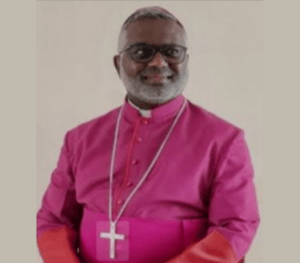
Province: KwaZulu-Natal
PATRON: Saints Mary and Anne
Rt. Rev,Bishop Neil Frank OMI, Bishop of Mariannhill
Ordained Bishop of Mariannhill on 26 February 2022
Latest Biography:
Bishop Neil Augustine Frank, O.M.I. was born in Pietermaritzburg in 1966. After High School he studied at the University of Natal (now, UKZN) and achieved a Masters degree in Physics in 1991. He joined the Oblates of Mary Immaculate and made his first profession on 6 February 1993. He began his studies at St Joseph’s Theological Institute (SJTI), Cedara and completed the philosophy theology studies at the Gregorian Pontifical University, Rome 1995-1998. He made his final vows as an Oblate in January 1998 and was ordained a priest on 21 August 1999.
Bishop Neil worked in parishes in the Archdiocese of Durban, 1999-2004. He pursued a Masters in Philosophy at the Jnana Deepa Vidya institute in Pune, India. From June 2006 to June 2010 he was lecturer in Philosophy at SJTI, being appointed Head of Department of Philosophy in 2008. Bishop Neil read for a PhD in Philosophy at UKZN, June 2010 to July 2012, graduating in 2014. He was appointed parish priest at St Mary’s in Pietermaritzburg, while continuing to lecture at SJTI. He was appointed Vice-President of SJTI in 2015 and in September that year was appointed President. When the 3 OMI Provinces of South Africa amalgamated in 2018, he was appointed Provincial Superior. On 17 December 2021 the Holy Father, Pope Francis, appointed him as Coadjutor Bishop of Mariannhill. He was ordained bishop on 26 February 2022, and became the Bishop of the Diocese of Mariannhill on 13 October 2022, when the incumbent bishop, His Excellency Bishop Pius Dlungwane retired.
Appointment date: 17 December 2021
Ordination date: 26 February 2022
Coat of Arms and Motto:
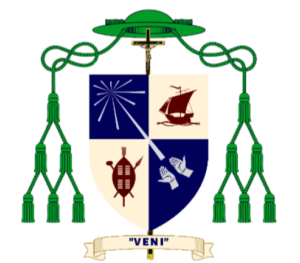
Predecessors:
- Adalbero Joseph Fleischer, C.M.M. † (22 Mar 1922 Appointed – 14 Apr 1950 Retired)
- Alphonse Streit, C.M.M. † (23 Dec 1950 Appointed – 21 May 1970 Retired)
- Martin Elmar Schmid, C.M.M. † (21 May 1970 Appointed – 18 Jun 1980 Died)
- Paul Themba Mngoma † (12 Feb 1981 Appointed – 7 Feb 2005 Resigned)
- Pius Mlungisi Dlungwane (3 Jun 2006 Appointed – 13 Oct 2022 Retired)
History of the Diocese:
In 1880, at the request of Bishop James David Ricards of the Eastern Vicariate of the Cape of Good Hope, Trappist Franz Pfanner, abbot of Mariastern Abbey in Banja Luka, Bosnia and Herzogovina, established a monastery near Sundays River Valley, in Dunbrody South Africa. Due to drought and wind the site proved unsuitable. With the permission of Bishop Charles Jolivet, O.M.I., of the Vicariate of Natal, Pfanner and his companions relocated to a part of the Zeekoegat farm, near Pinetown. Abbot Pfanner named the monastery Mariannhill after his stepmother, Marianna. Since their missionary activity was not entirely compatible with the contemplative focus of the Trappists, in 1909 the Holy See separated the monks of Mariannhill from the Trappists, forming the Congregation of the Missionaries of Mariannhill (CMM). By then, in 1904 Bishop Henri Delalle O.M.I. replaced Bishop Jolivet as the Apostolic Vicar for Natal. On September 10, 1921 the Apostolic Vicariate of Mariannhill was established from the Apostolic Vicariate of Natal. Bishop Fleischer was appointed Apostolic Vicar in March 1922. St. Joseph’s Catholic Church, built in 1908 was dedicated as the Cathedral on 24 April 1924 and is the seat of the Bishop of Mariannhill. Bishop Adalbert Fleischer founded the Daughters of St Francis of Assisi (FSF) in 1922 and the Franciscans Familiars of St. Joseph’s (FFJ) in 1923. The FFJ amalgamated with the Franciscan Third Order Regular in 1982.
Bishop Fleischer was succeeded by Bishop Streit in 1950. This coincided with the erection of the Diocese of Mariannhill on 11 January 1951 as suffragan to the Metropolitan Archdiocese of Durban. The Diocese measures 12,612 square kilometres. As of 2017, the diocese had a population of about 329,575 Catholics. Bishop Streit was succeeded by Bishop Schmid in 1970. He in turn was succeeded by Bishop Paul Themba Mngoma in 1981, the first African Bishop of the Mariannhill Diocese. Bishop Mngoma worked to increase the number of indigenous clergy. In response to a request from Bishop Pius Dlungwane for an Apostolic Visitation, Pope Francis appointed the Archbishop Emeritus of Pretoria in South Africa, Archbishop William Slattery O.F.M., to conduct the visitation. As a result of the visitation, in September 2020, Arcbishop Slattery was named Apostolic Administrator of the diocese while Bishop Dlungwane remained its spiritual head. On 17 December 2021, Monsignor Neil Augustine Frank, Provincial Superior of OMI in South Africa, was appointed Coadjutor Bishop, with special faculties, effectively taking over the administrative responsibilities of the Apostolic Administrator. He succeeded Bishop Pius Mlungisi who retired on 13 October 2022.
Postal Address:
Mariannhill Diocese
P.O.Box 11001
Mariannhill
3624
Tel: 031 700 2704
Email: bishop@domhill.org.za;
Website: in construction
Social media: Facebook: Diocese of Mariannhill – South Africa
Communication officer: Fr. Similo Mngadi Contact details:
Mobile number: 072 110 8613
Email: similomngadi@gmail.com
More Info: Here
Province of Durban
Patroness: Our Lady Assumed into Heaven
Rt Rev Bishop Sithembele Anthony Sipuka, Bishop of Mthatha
Appointed Bishop of Mthatha on the 8th of February 2008 and ordained Bishop on the 3rd May 2008 at Mthatha.
Postal Address:
PO Box 85, Mthatha 5100.
Chancery: 19 Craister Street,
Tel: 047 532 2914
Fax: 047 532 6301
Email: ssipuka@worldonline.co.za/
bishop@mthathadiocese.co.za
Coat of Arms and Motto
To care and to work
Predecessors
- Right Rev Bishop Emmanuel Hanisch (1930 – 1940), died 28 February 1940. Joseph Grueter (1941 – 1968), resigned November 1967, died 2 March 1976.
- Right Rev Bishop Henry Karlen (1968 – 1974), transferred to episcopal see of
Bulawayo on 15 August 1974. - Right Rev Bishop Peter Butelezi (1975 – 1978), transferred to Archepiscopal see of
Bloemfontein on 6 August 1978. - Right Rev Bishop Andrew Z Brook (1979 – 1995) resigned 26 January 1995, died 05
September 2011. - Right Rev Bishop Frederick Lobinger (appointed Apostolic Administrator) 26th January
1995 to 28th June 1997. - Rt Rev Bishop Oswald G Hirmer was appointed Bishop of Mthatha on 28
April 1997 and was ordained Bishop on the 28th June 1997 at Ikwezi Lokusa Grounds.
Retired 8th February 2008, died 04 March 2011.
History of the Diocese
Prior to 1922, the territory formed part of the Natal Vicariate and from 1922 to 1930 part of the Mariannhill Vicariate under Bishop Adalberto Fleischer. On 31 May 1930 it was made a Prefecture and in April 1937 a Vicariate.
The ecclesiastical territory of the Diocese of Mthatha (Umtata) comprises the following civil districts: Mthatha, Libode, Ngqeleni, Port St John’s (Mzimvubu), Mqanduli, Elliotdale (Xhora), Cala, Ngcobo (Engcobo), Tsolo, Qumbu, Mount Fletcher, part of Matatiele with the Kenera river as boundary Elliot and Maclear (Nqanqaru), Eastern Cape.
More Info: Here
Name of Diocese: Kokstad
Province: Durban
PATRON: ST. PATRICK
Rt. Rev, Bishop Victor Mbuyisa CMM Bishop of Kokstad
Ordained Bishop of Kokstad on 11 June 2022
Latest Biography: Born on the 13 th Feb 1973, subsequently in 1992, became the Member of Congregation of Mariannhill Missionaries. He took his Perpetual Vows as a Member of Congregation of Mariannhill Missionaries on the 2 nd Feb 1997. Ordained Priest of Congregation of Mariannhill Missionaries on the 04 th March 2000. Studied philosophy
(1994-96) and theology (1996-99) at St. Joseph’s Theological Institute in Cedara, South Africa. Subsequent positions: Parish Vicar of St. Michael’s Mission, Chaplain of
Mangosuthu University of Technology and of St. Francis College of Mariannhill and Vice- Director of Novices (2001-2002); Licentiate in Canon Law from Saint Paul University in Ottawa, Canada (2002-2004); Chaplain of Mangosuthu University of Technology and Vice- Director of Novices (2005-2007); Superior and formator at the Nivard House Formation House in Nairobi, Kenya (2007-2010); Provincial Superior of the Mariannhill Missionaries in East Africa, Nairobi, Kenya (2010); Councilor and Secretary General (2010-2012), Vicar
General and Procurator of the Congregation of the Missionaries of Mariannhill (2012-2016). Superior General of the Congregation of the Missionaries of Mariannhill (2016-2022). Appointed and Ordained Bishop of Kokstad (2022). Synod Delegate of the XVI Ordinary General Assembly of the Synod of Bishops (2023 & 2024).
Appointment date: 06 APRIL 2022
Ordination date: 11 JUNE 2022
Coat of Arms and Motto:
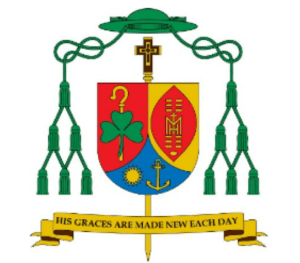
Predecessors:
- Rt Rev Sigebald Kurz, OFM, Rt Rev Lucas Puerstinger, OFM (Apostolic Administrator), Rt Rev John Evangelist McBride, OFM, Rt Rev Wilfrid F Napier, OFM, Rt
- Rev William Slattery, Rt Rev Stanislaw Jan Dziuba OSPPE (Apostolic Administrator)
- Rt Rev Zolile P Mpambani S.C.J
History of the Diocese:
By Papal Decree of 8 April 1935, the Kokstad District of the Mariannhill Vicariate was constituted the Prefecture Apostolic of Mount Currie. The Prefecture Apostolic of Mount Currie became the Vicariate Apostolic of Kokstad on 11 July 1939 and was entrusted to the Franciscan Fathers (Order of Friars Minor, OFM). Rt Rev Sigebald Kurz, OFM became the first Bishop. He resigned in 1945 and Rt Rev Lucas Puerstinger, OFM was Apostolic Administrator until 1949 when Rt Rev John Evangelist McBride, OFM was appointed Bishop and remained in office until his resignation in 1978, when Rt Rev. Wilfrid F Napier, OFM was appointed Apostolic Administrator and later Bishop. In 1992, Rt Rev William Slattery OFM was appointed in 1992 until his transfer to Archdiocese of Pretoria in 2009 and Rt Rev Zolile P Mpambani S.C.I was appointed in 2013 until his transfer to Archdiocese of Bloemfontein in 2020. With the establishment of the hierarchy in 1951, the diocese of Kokstad came into existence and comprises the magisterial districts of Bizana, Flagstaff, Lusikisiki, Port St John on the left bank of the Umzimvubu River, Mount Ayliff, Mount Frere, Tabankulu, Mount Currie and Matatiele south of the Kenegha River.
Postal Address:
97 St John’s Street / PO Box 65, Kokstad 4700.
Tel: 039 727 2239
Fax: 039 727 1151
Email: chancellor@kokdiocese.org, bpa@kokdiocese.org
Social media: Diocese of Kokstad (Facebook, X/Twitter, Instagram, YouTube), and Kostaddiocese (TikTok).
Communication officer: Fr. Napo Joseph Swayi,
Email: chancellor@kokdiocese.org
Cell: 0835140734
More Info: Here
Name of Diocese: Dundee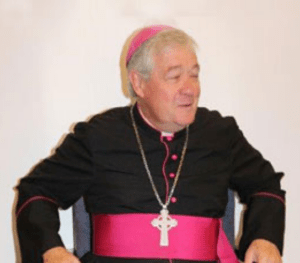
Province: Durban
PATRON: Our Lady / St Francis of Assisi
BISHOP Full Name: Thomas Graham Rose
Latest Biography: Area 51 867 sq. Km. Total Population: 1 700 000, Catholic
Population: 125, 200
Appointment date: 13 June 2008
Ordination date: 30 August 2008
Coat of Arms and Motto: Et in Ipso Omnia Constant
Predecessors:
- Rt Rev Mgr C Ulyatt OFM
- Marius Banks OFM
- Michael Paschal Rowland OFM
History of the Diocese:
The former Prefecture Apostolic of Volksrust was erected by the Bull “In Similitudinem” of Pius XII dated 23 June 1958, and entrusted to the English Province of the Order of Friars Minor. The boundaries of the territory are: Witbank Diocese to the North, Johannesburg Archdiocese to the North-West, Bethlehem Diocese to the West, Manzini Diocese to the East and Durban Archdiocese to the South. The Prefecture comprised the following Districts: Ermelo, Standerton, Bethal, Piet Retief, Amersfoort, Volksrust, Wakkerstroom in Mpumalanga and Newcastle, Utrecht, Dundee, Klip River and Msinga districts (as bounded by the Tugela River) in KwaZulu/Natal. The Prefecture was created a Diocese under the Title, Diocese of Dundee, by the Bull of Pope John Paul II “Quandoquidem Ecclesia” dated 19 November 1982. Michael Paschal Rowland OFM was ordained the first bishop of the diocese on the 17 September 1983. Resigned in virtue of Canons 401 par. 1 and 411, accepted by the Holy See 30 September 2005.
Postal Address: Postnet Suite 95, Private Bag X 6603, Newcastle 2940
Tel: (034) 312 6591
Fax: No fax line
Email: dundeediocese@gmail.com
Communication officer: Dumisani Mbokazi
Contact details: (034) 3126591
Mobile number: 0729565115
Email: dundeediocese@gmail.com
Name of Diocese: ARCHDIOCESE OF CAPE TOWN
Province: Metropolitan Archdiocese of Cape Town
PATRONS: Our Lady of the Flight into Egypt (1st Sunday in February); St Patrick (17 March)
Latest Biography: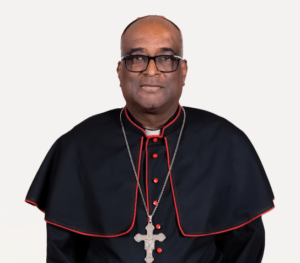
• Born in Durban on 15 August 1953.
• Oblate Formation: OMI Pre-Novitiate at Cleland 1982-3; OMI Novitiate in Johannesburg in 1984 and First Vows in January 1985;
Final Vows in Durban in 1988; Seminary Formation: St Joseph’s Scholasticate, Cedara 1985-1990
• Ordained a priest on 8 February 1991.
• Ordained Auxiliary Bishop of Cape Town on 25 August 2019.
Coat of Arms and Motto:
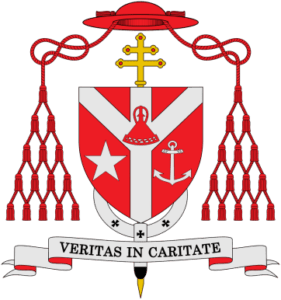
The Coat-of-Arms of Cardinal Brislin shows on a red shield a silver pall, which symbolises the cross as the instrument of salvation. On it is placed a red Basotho hat (mokorotlo) that represents the Cardinal’s roots in the Free State.
Below the pall is the star that symbolises the Southern Cross and the patronage of Our Lady of the Flight Into Egypt; as well as the anchor, a symbol of hope that reflects Cape Town’s location at the Cape of Good Hope. Behind the shield is the patriarchal cross and the pallium, both indicating that he is the Archbishop of a Metropolitan see.
As a member of the College of Cardinals the coat of arms is surmounted by a scarlet galero with 15 tassels (fiocchi) on each side. The Cardinal’s motto “Veritas in Caritate” (Truth in Charity) remains unchanged since his first appointment as bishop of Kroonstad.
Predecessors:
- Rt Rev. Patrick Raymund Griffith, OP
- Titular Bishop of Palaeopolis, consecrated 24th August 1837, Vicar Apostolic of the Cape of Good Hope, died 18th June 1862.
- Rt Rev. Thomas Grimley
Titular Bishop of Antigone, consecrated 25th January 1861, died 29th January 1871. - Rt Rev. John Leonard
Titular Bishop of Charadro, consecrated 15th December 1872, died 19th February 1908. - Rt Rev. John Rooney
Titular Bishop of Sergiopolis, consecrated 21st September 1886, retired 1924, died 26th February 1927. - Rt Rev. Bernard Cornelius O’Riley
Titular Bishop of Anastasiopolis or Phoba, consecrated 6th January 1926, retired 6th June 1932, died 21st July 1956. - Rt Rev. Bishop F Hennemann, SAC
- Titular Bishop of Coptus, consecrated 6th April 1914, Appointed to the Vicariate of Cape Town 30th June 1933, nominated Assistant at the Pontifical Throne 18th May 1939, died 17th January 1951.
- His Eminence Owen Cardinal McCann Ordained Vicar Apostolic of Cape Town, 18th May 1950, Appointed Archbishop of Cape Town 11th January 1951, Created Cardinal 22nd February 1965. Retired 16th December 1984, died 26 March 1994.
- Most Rev. Stephen Naidoo CSsR Ordained Auxiliary Bishop of Cape Town 15th September 1974, installed as Archbishop of Cape Town on 16th December 1984. Died 1st July 1989.
- Rt Rev. Bishop Reginald Cawcutt Nominated Titular Bishop of Cabra on 29th May 1992, ordained Auxiliary Bishop of Cape Town on 26th August 1992, resigned 17th July 2002. Died 5th August 2022.
- Most Rev. Lawrence Patrick Henry Nominated Titular Bishop of Cenculiana on 16th May 1987. Ordained Auxiliary Bishop of Cape Town on 16th August 1987, elected Diocesan Administrator on 3rd July 1989, appointed Archbishop of Cape Town on 17th July 1990 and was installed on 29th August 1990. Retired on 7 February 2010. Died 4 March 2014.
History of the Diocese
A BRIEF HISTORY OF THE ARCHDIOCESE OF CAPE TOWN
Long before the arrival of the Dutch East India Company, Portuguese navigators had consecrated the land by erecting stone crosses and naming landmarks in honour of the Deity, the Blessed Virgin, and the Saints; but from the founding of the Cape Colony in 1652 no Divine Worship was permitted except according to the Dutch Reformed tradition. Soon after the first British seizure of the Cape in 1795, the Holy See’s first efforts to evangelise southern Africa were frustrated by the tumult caused by the French Revolution. In 1803, following the restoration of the colony to the Dutch, she negotiated aid from the Batavian government for two Dutch priests to serve as army chaplains. Accompanied by a third priest mandated by the Holy See to evangelise the “Ottentoti”, they arrived in October 1805 but four months later the newly victorious British repatriated all three along with the Dutch garrison.
On 7 June 1818, Pope Pius Vll erected the Vicariate “of the Cape of Good Hope with adjacent territories, and the island of Madagascar”, entrusting it to the English Benedictine Bede Slater to whom, the following year, the Mauritius Vicariate was also confided (March) as were the Australian colonies (April). On New Year’s Day 1820, breaking his voyage to Mauritius, Bishop Slater left Fr Scully at Cape Town to serve the resident Catholics (mostly Irish soldiers). Scully built a church and parsonage and was succeeded by a Dutch priest Rev. Wagener and an English Benedictine Rev. Rishton (whose ministries overlapped). Fray Moral, a Spanish Dominican priest, ministered during calendar 1836. Slater, meanwhile, had been recalled from Mauritius and replaced by another Benedictine, Bishop Morris. In 1834 Gregory XVI relieved Morris of Australia and three years later of the reduced Cape Vicariate (Madagascar had been detached in 1829).
The Irish Dominican Patrick Griffith was appointed the first resident bishop for southern Africa in 1837 (the Briefs are dated 6 June). He disembarked at Cape Town on Holy Saturday 1838 (14 April). In July 1847, at his request, Pope Pius IX divided the Cape of Good Hope Vicariate into two: the Western District and the Eastern District. Following a request made by Bishop Grimley in 1870 while in Rome for the Vatican Council, an Apostolic Brief dated 11 August 1874 announced the division of the Western Vicariate by the deduction of the Central Prefecture extending from Mossel Bay in the south-east to Namaqualand in the north. In 1885 lack of personnel obliged the Society of African Missions to resign the Prefecture. The southern part (now the diocese of Oudtshoorn) temporarily reverted to the bishop in Cape Town, and the northern part (now the dioceses of Keimoes-
Upington and Keetmanshoop) was entrusted to the Oblates of St Francis de Sales. In 1922 the southern part of the Central Prefecture was entrusted to the German Pallottines. On 13 June 1939, the names of the Western and Eastern Vicariates were changed to Cape Town and Port Elizabeth respectively. On 11 January 1951, Pope Pius Xll established the ecclesiastical hierarchy in southern Africa, elevating the vicariates to the rank of diocese organised as four ecclesiastical provinces each headed by an archdiocese. These incorporated all the ecclesiastical territories within the Republic of South Africa, Lesotho, Swaziland, and Botswana. Owen McCann (Vicar Apostolic since May 1950) was the first archbishop of Cape Town.
Further structural development has taken place since with the creation of new dioceses and the erection in 2007 of the province of Johannesburg and the reallocation of some suffragan sees. The archdiocese is centred on the city of Cape Town, extending north and east from the Cape of Good Hope, the south-western corner of South Africa, and includes the southernmost tip of the continent of Africa. Its area is bounded on the west by the Atlantic Ocean, on the north by the diocese of Keimoes-Upington and the southern boundary of the Matzikama Local Municipality (Vredendal), on the east by the diocese of Oudtshoorn and the western boundaries of the Hantam (Calvinia NC), Witzenberg (Ceres), Breede Valley (Worcester), Langeberg (Ashton) and Swellendam Local Municipalities, and on the south by the Indian Ocean. Besides the City of Cape Town Metropolitan Municipality, it includes the following Local Municipalities: Swartland, Saldanha Bay, Bergrivier, Cederberg (West Coast
District Municipality), Drakenstein, Stellenbosch (Cape Winelands District Municipality), Theewaterskloof, Overstand and Cape Agulhas (Overberg District Municipality). The islands of St Helena, Tristan da Cunha and Ascension were part of the Archdiocese of Cape Town from 1852 until 18 August 1986 when they were erected as a mission sui juris and transferred to the Prefecture of the Falklands with an Apostolic Administrator being Ecclesial Superior for these islands. This mission sui juris is one of only several others in the world and comes directly under the Dicastery for Evangelisation in Rome and the Holy Father. Since 1986 until 2008 the Prefecture had been in the care of the Mill Hill Fathers and priests of the Society of African Missions, but in 2016 Abbot Hugh Allan, OPraem was appointed with Episcopal rights and responsibilities as Prefect and Apostolic Superior. The church dedicated to the Sacred Heart on the Island of St Helena was inaugurated for the first time in November 1852 by visiting Bishop Patrick Griffith OP, Vicar Apostolate of the Western District (of the Cape of Good Hope) when he confirmed some 30-odd candidates.
The parish church on the Island of St Helena has the unique feature of being the oldest extant building after the cathedral in the
Archdiocese, followed later by the re-building of the church in Simons Town.
Area: 30 892 sq.km.
Total Population: 4 975 701
Catholic Population: 276 415
Postal Address: The Chancery, 12 Bouquet Street / PO Box 2910, Cape Town 8000.
Tel: 021 462 2417
Fax: 021 461 9330;
Email: Archdiocese of Cape Town: chancery@adct.org.za; Cardinal Stephen Brislin: archbishop@adct.org.za
Website: https://adct.org.za/
Social media: Facebook, Youtube
Communication officer: Mr Stephen Docherty
Contact details:
Tel: 021 462 2417
Email: publications@adct.org.za
More Info: Here
Province of Cape Town
Patron: The Sacred Heart of Jesus
Rt Rev Bishop Joseph Kizito, Bishop of Aliwal North
Ordained Bishop of Aliwal North on 15 February 2020
Postal Address:
53 Cathcart Street / PO Box 27, Aliwal North 5530
Residence: 53 Cathcart Street, Aliwal North.
Tel: 051 633 2342 / 633 2759
Fax: 051 633 3078.
E-mail:contact@catholic-aliwal.org.za/diocesedeaar@gmail.com
Coat of Arms and Motto
Love one another
Predecessors
- Rt Rev Bishop FW Demont SCJ 1936-1944. Died 1964 in Germany.
- Rt Rev Mgr PL Meyer SCJ Acting Administrator 1944-1946. Died 1965 in USA.
- Rt Rev Bishop J Lueck SCJ 1947-1973. Died 2000 in Germany.
- Rt Rev Bishop E Baaij SCJ 1974-1981. Resigned 30th October 1981. Nazareth
House, 10 Park Lane, Port Elizabeth 6001. Tel: 041 373 1948. Died 31 January
2012. - Rt Rev Bishop J De Palma SCJ, Apostolic Administrator 1981-1986. Retired 18 November 1987. Died 3rd February 2005.
- Rt Rev Bishop Fritz Lobinger. Retired 29 April 2004.
- Rt Rev Bishop Oswald Hirmer, Apostolic Administrator 2004-2008, died 5.3.2011.
- Rt Rev Bishop Michael Wüstenberg, Bishop 19 December 2007, Retired Day, Month, 2017
History of the Diocese
This ecclesiastical territory was entrusted to the Congregation of the Priests of the Sacred Heart in 1923, and was formerly known as the Gariep Prefecture. The Rt Rev Mgr FW Demont, SCJ, was the first Prefect Apostolic. In 1936 the Prefecture was raised to the status of Vicariate and became known as the Aliwal Vicariate. It was erected as diocese in 1951. In 1953 the Western portion of the Diocese was detached and became the Prefecture of De Aar. The Diocese of Aliwal now comprises (parts of) the municipalities of Inkwanca, Gariep, Kopanong-Xhariep, Maletswai, Senqu and Ukhahlamba.
More Info: Here
Province of Cape Town
Patroness: Our Lady of Assumption
Rt Rev Bishop Adam Musialek SCJ, Bishop of De Aar.
Ordained Bishop of De Aaron on 24 September 2009
Postal Address:
PO Box 73, De Aar 7000.
Residence: 1 Van Riebeeck Street.
Tel: 053 631 1149
Fax: 053 631 1043
E-mail: diocesedeaar@gmail.com
Coat of Arms and Motto
Ecce venio
Predecessors
- Rt Rev. Joseph De Palma SCJ was consecrated first Bishop of De Aar on 19 July 1967. Died February 2, 2005.
- Rt Rev. Frederick Lobinger was Apostolic Administrator from 13 March 1988 to 30 April 1992.
- Rt Rev. Joseph Potocnak SCJ, appointed Bishop of De Aar on February 12, 1992, ordained Bishop May 1, 1992 and retired 23 September 2009.
- Rt Rev Adam Musialek SCJ appointed Bishop of De Aar on 17 July 2009 and ordained Bishop on 24 September 2009.
History of the Diocese
On 24 March 1953, this Territory (formerly included in the Aliwal Diocese) was made a Prefecture and entrusted to the American Province of the Priests of the Sacred Heart. The Rt Rev Mgr AJ Dettmer SCJ was appointed the first Prefect Apostolic. By decree of the Holy See, dated 13 April 1967, the Prefecture was elevated to the status of a Diocese.
The boundaries of the Territory are: Aliwal Diocese to the East, Kimberley Diocese to the North, Keimoes Diocese to the Northwest, Oudtshoorn to the Southwest, and Port Elizabeth to the South. The diocese comprises Britstown, Colesberg, De Aar, Graaff- Reinet, Hanover, Hopetown, Jansenville, Middelburg, Murraysburg, Noupoort, Philipstown and Richmond districts.
Province of Cape Town
Patron: The Immaculate Heart of Mary
Rt Rev Bishop Noel Rucastle, Bishop of Oudtshoorn
Ordained Bishop of Oudtshoorn on 08 August 2020
Postal Address:
PO Box 97, Oudtshoorn, 6620.
Residence: 46 St. Saviour Street, Oudtshoorn, 6625.
Tel: 044 272 5054
Fax: 044 272 8908
Coat of Arms and Motto
Predecessors
- Rev. Fr. Davenoille, Prefect Apostolic 1874
- Rt Rev. Fr. Gaudeul, Prefect Apostolic 1882
- The Vicars Apostolic of Cape Town, 1882 – 1922
- Rt. Rev. Bishop F Hennemann, S.A.C., Titular Bishop of Coptus, Prefect Apostolic 1922 -1933;
- Rt. Rev. Mgr T Koenig, S.A.C., Prefect Apostolic 1934 – 1948;
- Rt. Rev. B Hippel, S.A.C., Titular Bishop of Abora, Vicar Apostolic of Oudtshoorn, 1948 – 1951, became Bishop of Oudtshoorn with the establishment of the Hierarchy on 11 January 1951. He retired on 29 September 1968 and died on 7 November 1970
- Rev. Fr. J Rosner, S.A.C., Apostolic Administrator 1968 to June 1969
- Rt. Rev. Bishop M Gottschalk, S.A.C., consecrated Bishop on 11 June 1969 and died on 20 April 1982;
- Rt. Rev. Bishop E.R. Adams, consecrated bishop on 16 July 1983 and retired 28 May 2010.
- Rt. Rev. Bishop Francisco de Gouveia, Consecrated bishop on the 17 July 2010 and Retired 02 July 2018.
History of the Diocese
The Diocese of Oudtshoorn was first established as the Central Prefecture by decree of the Holy See on 24 May 1872. Till then, it had been part of the Western Vicariate. On 13 July 1874 its care was entrusted to the “Missionaries for African Missions of Lyons”. When the Fathers of Lyons left the Central Prefecture in 1882, the Western part of the Prefecture was given to the Oblates of St. Francis of Sales and a new Prefecture was erected in 1884. The Eastern part again came under the jurisdiction of the Vicar Apostolic of the Western Vicariate as the Central Prefecture until 1922, when it was separated from the Western Vicariate and entrusted to the Pious Society of Missions, now called the Society of the Catholic Apostolate (Pallottine Fathers).
On 13 June 1939, the Central Prefecture became the Prefecture of Oudtshoorn which in turn was raised to the status of Vicariate on 9 December 1948. The Diocese of Oudtshoorn was constituted on the establishment of the Catholic Hierarchy of Southern Africa on 11 January 1951. The Diocese has for its boundaries on the West, the eastern boundaries of Bredasdorp, Caledon, Paarl, Malmesbury, Clanwilliam, Van Rhynsdorp and Namaqualand districts; on the North, the southern boundaries of Kenhardt and Prieska districts; on the East, the western boundaries of Britstown, Richmond, Murraysburg, Aberdeen, Jansenville and Humansdorp districts; and on the South the Indian Ocean and the northern boundaries of Caledon and Bredasdorp districts. By decree of the Holy See the districts of Calvinia and Williston were separated from the Diocese of Oudtshoorn in 1979 and now fall under the jurisdiction of the Ordinary of the Diocese of Keimoes- Upington.
More Info: Here
Province of Cape Town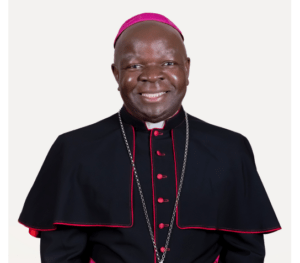
Name of Diocese: CATHOLIC DIOCESE OF PORT ELIZABETH
Province: EASTERN CAPE(EC) (Politic Province)
Metropolitan Province: CAPE TOWN
PATRON: OUR LADY OF THE FLIGHT INTO EGYPT; ST PATRICK
BISHOP Full Name: Rt. Rev Bishop Vincent Mduduzi Zungu Port Elizabeth
Appointment date: 2 February 2014
Ordination date: 28 JUNE 2014
Latest Biography:
Vincent Mduduzi Zungu was born on 28 April 1966 in Mbongolwane, in the Diocese of Eshowe, to Gervas Zungu and Anna Zungu, born Makhoba. He has 3 brothers and 5 sisters. He was baptised a few days later and put under the patronage of St. Vincent de Paul, a French saint who dedicated his life to the formation of the religious and Clergy and looked after the poor and sick in Paris. His education took place at Samungu Primary School and Ndluyesilo High School. Having shown some desire to discern a possible vocation to the religious life and priesthood, he was sent to the Catholic Boarding School at Mahlabathini, north of Ulundi. Here he attended several vocation workshops presented by the Benedictines and the Eshowe Diocese. After completing his Matric he joined the Franciscan Postulancy in 1987 at Holy Cross Mission. On 19 January 1989 he made his first religious vows at St. Joseph’s Mission. He pursued philosophical studies at the Franciscan Studium Philosophicum and completed his theological studies at St. John Vianney Seminary in 1994 where he also obtained his BST from the Pontifical University Urbaniana On 2 July 1994 he took his Perpetual vows in his home parish of St. Joseph’s at Mbongolwane. On 15 August 1994 he was ordained deacon at Sacred Heart Cathedral, Pretoria, by Archbishop William Slattery OFM.
On 8 July 1995 Deacon Vincent Zungu was ordained priest at Holy Cross Mission, Gingindlovu by Bishop Mansuet Dela Biyase of the Eshowe Diocese. He was appointed assistant priest at Hardenberg Mission and was also involved with vocational promotion and formation of Franciscan postulants. In the second half of 1999 he attended a formation course at the Antonianum in Rome and was appointed novice master of the Franciscans at the end of the same year. Fr. Zungu was sent to France for further studies between 2001 and 2003, where he lived with the local Franciscan community in Strasbourg. After his return he was appointed student master of St. Francis House and taught moral theology at St. John Vianney Seminary from 2004—2006. In 2007 he was transferred to the newly established Postulancy House in Grahamstown. There he was postulant master until the end of 2008. In December 2008 he was elected Minister Provincial of the Franciscans and 6 months later attended the General Chapter of the Order of Friars Minor in Assisi. There he was elected as General Definitor for the whole Order. He resided at the General Curia of the Order in Rome and served as link between the Franciscan leadership in Rome and the Franciscan Provinces in Africa spread out in 32 countries. Fr. Zungu speaks English, French, Italian, Zulu, Sotho and Xhosa. On 2nd February 2014 the Holy Father, Pope Francis, appointed Fr. Vincent Mduduzi Zungu bishop for the Diocese of Port Elizabeth. The Episcopal Ordination took place on the 28th June 2014.
Coat of Arms and Motto: UT UNUM SINT
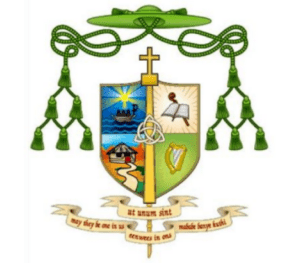
- Right in the centre of the shield, the crest is dominated by the ‘Diaz cross’ or padrao as it is sometimes
called. It represents the earliest known contact of Christianity with this Southern part of Africa. It recalls
the Portuguese explorer Bartholomew Diaz who landed just east of Algoa Bay at Kwaaihoek in March 1488 and planted the padrao cross on African soil in honour of the Christian faith. The 1st Mass may have been celebrated as well.
2. In the upper right-hand quarter is the Star of the Sea representing the Blessed Virgin Mary, the principal Patroness of the Diocese, invoked under the title of ‘Our Lady of the Flight into Egypt’ which is
traditionally celebrated every year in February. We pay homage to God and honour the memory of many missionaries who came on our beautiful sea shores to bring Christ to local people and joy of the Gospel.
3. In the right-hand quarter below is a setting of an African home along the coast, surrounded by hills and green pastures, with a wide country road leading straight home. The home represents African values of family, such as, love, joy, celebration, compassion, respect, inter-generational solidarity, hospitality, warmth, identity, belonging, reconciliation etc. encapsulated in the belief system of “Ubuntu” ( ‘humane-
ness’). A home is a sacred place where our first encounter with God is realized in the heart of the family. The Catholic Church sees itself as ‘Family of God in Africa’ where people of different languages and cultures are made to ‘feel at home’ – all the more this year (2014) dedicated to the Family.
4. In the left-hand quarter bellow is a golden harp representative of the yful faith of Irish missionaries: both, Diocesan and Religious, as well as male and female. Their spiritual, human and material contribution in the life of the local Church is immense. It is by no coincidence that the second Patron of the Diocese after the Blessed Virgin Mary is St Patrick. They are a constant reminder that the Church is by nature missionary, that’s the purpose for which it was founded and the reason for which it continues to exist. It is there to evangelize.
5. In the upper left-hand quarter is a Bishop’s golden staff, the crosier, recalling his principal ministry as shepherd. He must know his sheep so well that he “has a smell of their odour” as Pope Francis said on one occasion. The open book represents the Word of God, which is the source of life and the highest authority of the Church and the diocese.
6. All these old and new Christian traditions and symbols representing the rich cultural and linguistic diversity of the territory of the Diocese find their meaning, integration and unity in the life of God revealed by Jesus as the Divine Family of the Father, the Son and the Holy Spirit. The interwoven ‘Celtic rings’ in the centre of the crest represent the Most Holy Trinity, the founding principle of our Christian faith.
7. The Bishop’s motto is “ut unum sint” (Latin), “may they be one in us” (English), “eenwees in ons” (Afrikaans) and “mababe banye kuthi” (Xhosa) is taken from what has become known as the priestly prayer of Jesus recorded in the Gospel of John Chapter 17 verse 21. Jesus is filled and moved by the Holy Spirit and prays to God the Father for the unity of his disciples and all believers. The Bishop was informed of his pending appointment by the Holy Father during the last week of praying for Christian unity on the 22nd of January. It was officially made public on the 2nd of February, Feast of the Presentation of the Lord in the Temple in Jerusalem.
8. The crest was designed by ‘Design at Bay’, presented as a gift to the new Bishop and to the Catholic Diocese of Port Elizabeth by Mrs Dipti Varghese, her family and their dedicated staff. The Bishop and the Diocese extend their most sincere gratitude to Mrs Varghese, the family and to the artists for this inspiring masterpiece.
Predecessors:
- BISHOP MICHAEL GOWER COLEMAN
History of the Diocese:
It was erected as the Vicariate Apostolic of PORT ELIZABETH, formerly known as the Vicariate Apostolic of the Eastern Cape Districts of the Eastern Cape of Good Hope.
Postal Address: 4 How Ave Port Elizabeth Central 6001 / PO Box 12194, Centrahil 6006
Tel: 041 373 6735
Fax: 041 374 3921
Email: Office: secretary@catholic-pe.co.za
Website: Website
Social media: Rebecca Huntly
Communication officer: Fr. Gabriel Muyenga
Contact details: 078 6931096, muygabkab89@gmail.com
More Info: Here
 Province of Cape Town
Province of Cape Town
Patron: Christ the King
Rt. Rev Bishop Sphiwo Vanqa, Bishop of Queenstown
Ordained Bishop of Queenstown on 29 May 2021
Postal Address:
PO Box 182, Queenstown, 5320
Residence: “Mayfield” 10–12 Grey Street, Queenstown, 5319
Tel: 045 839 7325
Fax: 045 838 2209
E-mail: bishopqtn@telkomsa.net
COAT OF ARMS AND MOTTO

PREDECESSORS
- Rt Rev Mgr Vogel SAC, († 11 May 1936).
- Rev Fr P Hoffend SAC, as Administrator, until 1937
- Rt Rev Bishop J B Rosenthal SAC, retired 2 February 1972 († 22 May 1975)
- Rt Rev Bishop JB Rosner SAC, retired 28 April 1984 († 8 April 1998).
- Rt Rev Bishop Herbert Nikolaus Lenhof SAC, Appointed Bishop of Queenstown 3 February
1984, ordained bishop: 28 April 1984. Resigned 16 November 2009. - Rt Rev Bishop Michael Wüstenberg, Apostolic Administrator from 16 November 2009 to 6 August 2011.
- Rt. Rev Bishop Dabula Anthony Mpako, appointed Bishop of Pretoria
HISTORY OF THE DIOCESE
On 20 February 1929, the civil districts forming the Diocese of Queenstown were separated from the Eastern Vicariate (Port Elizabeth) and entrusted to the “Pious Society of Missions” (Pallottine Fathers and Brothers). In 1947 the Holy See restored the original name given to the Society by the Founder, Saint Vincent Pallotti: “Society of the Catholic Apostolate” (Societas Apostolatus Catholici, abbreviated: “S.A.C.”).
The diocese originally comprised the districts of Queenstown, Cathcart, Stutterheim, Tarka, Hofmeyr, Glen Grey, Stockenström, Maraisburg and a part of St Mark’s. By decree of the Sacred Congregation de Propaganda Fide, approved by Pope Pius XII on 7 February 1952, the magisterial districts: St Mark’s, Tsomo, Ngqamakhwe, Butterworth, Dutywa, Centane and Willowvale, which, until then, had formed part of the Umtata Diocese, were incorporated into the Diocese of Queenstown.
Name of Diocese: Archdiocese of Bloemfontein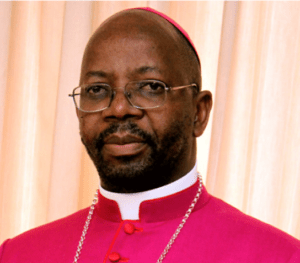
Province: Free State
PATRON: The Sacred Heart of Jesus
BISHOP Full Name: Most Rev Archbishop Zolile Mpambani SCJ, Archbishop of Bloemfontein
Latest Biography: Head of the Department for formation, Life and Apostolate of the Laity Bishop.
Installed: 19 June 2020 Archbishop of Bloemfontein
Coat of Arms and Motto:
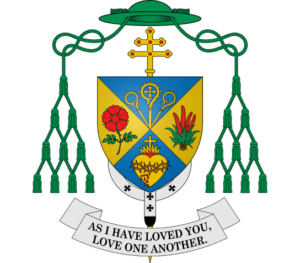
As I have Loved You, Love One Another
Predecessors:
- Archbishop H. J. Meysing. (1951-1954)
- Archbishop W.P. Whelan (1954-1966)
- Archbishop J. P. Fitzgerald (1966-1976)
- Archbishop P. J. Butelezi (1978-1997)
- Archbishop B. J. Tlhagale (1999-2003)
- Archbishop J.A. Nxumalo (2005-2020)
History of the Diocese
On 11 January 1951 Pope Pius XII established the Ecclesiastical Hierarchy in the Union of South Africa and set up the Ecclesiastical province of Bloemfontein. It comprises the Archdiocese of Bloemfontein and the following suffragan dioceses: Bethlehem, Kroonstad, Kimbereley, Keimoes-Upington. The former Archbishops were Archbishop H. J. Meysing. (1951-1954) Archbishop W.P. Whelan (1954-1966), Archbishop J. P. Fitzgerald (1966-1976) Archbishop P. J. Butelezi (1978-1997) Archbishop B. J. Tlhagale (1999-2003). The Archdiocese includes the civil districts: Bloemfontein, Boshof, Botshabelo, Brandfort, Bultfontein, Dealesville, Dewetsdorp, Edenburg, Excelsior, Fauresmith, hertzogville, Hobhouse, Jacobsdal, Koffiefontein, Luckhoff, Marseilles, Petrusburg, Phillipolis, Redderburg, Smithfield, Thaba Nchu, Trompsburg, Tweespruit, Verkeerdevlei, Wepener, Zastron, and portion of Ladyband, Hoopstad.
Postal Address:
7A Whites Road,
Bayswater,
Bloemfontein
9300
Tel: 051 448 1658
Email: admin@archbfn.co.za or archbishop@archbfn.co.za
Social media: Facebook
Address: 7A Whites Rd / PO Box 362, Bloemfontein 9300
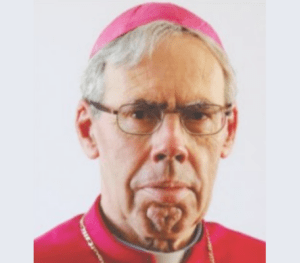
Province: Free State
PATRON: Immaculate Heart of Mary
BISHOP Full Name: Rt Rev Bishop Jan De Groef M. Afr, Bishop of Bethlehem
Latest Biography: Bishop Jan De Groef was born in Belgium on the 7 January 1948. He entered as candidate of the Missionaries of Africa in 1972 in Louvain and did his noviciate in Birkdale, Great Britain in 1974. He did his theology studies at the Missionary Institute London in London from 1974 till 1979. He was ordained priest on 7 July 1979 at his home parish in Belgium. He arrived in Africa on the 15 February 1980 and in Bethlehem on 6 March. He was a member of the Pastoral Animation Team and worked in Senekal, Qwaqwa and Bohlokong-Bethlehem until 1990. He turned back in Belgium for 5 years then went to Burkina Faso for five years before coming back to South Africa where he worked in Pretoria Archdiocese. His last appointment was in Merrivale, Cedara. In 2007 he was appointed as the sector superior of the Missionaries of Africa working in South Africa. On the 31 December 2008, he was appointed as bishop-elect of the Diocese of Bethlehem.
Appointment date: the 31 December 2008
Ordination date: 28 th March 2009
Coat of Arms and Motto:
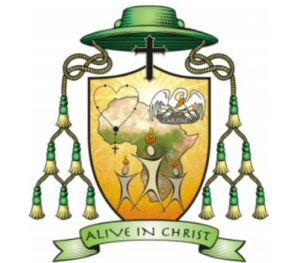
“Alive in Christ” is taken from Gal 2: 20. Our life as Christians and still more as priests and bishops is to be a sharing in the death and resurrection of the Lord
Predecessors:
- Leo Klerlein CSSp Vicar Apostolic of Kroonstad 8 April 1935 – died 22 May 1950
- Bishop P Kelleter CSSp first bishop of the Diocese of Bethlehem 11 January 1951; died 7th January 1991.
- Bishop Hubert Bucher. Retired since March 2009
History of the Diocese:
Prior to 1924 this territory formed part of the Kimberly Vicariate. From 1924 it was known as the Kroonstad Vicariate. Msgr. Leo Klerlein CSSp was appointed Prefect Apostolic in 1924, Vicar Apostolic in 1935. By Papal Decree dated 12 February 1948, the Sacred Congregation of Propagation of the Faith partitioned the Kroonstad Vicariate into two separate Vicariates. The western part with Kroonstad was entrusted to the Dominican Fathers of the Dutch Province. The eastern part with Bethlehem was entrusted to the Holy Ghost Fathers (CSSp) of the German Province. Msgr. Klerlein retired in 1948, with the creation of the new Vicariate. He was succeeded in 1950 by Bishop Peter Kelleter CSSp, who resigned on 5 July 1975. He was succeeded by Bishop Hubert Bucher, who came to South Africa as a Fidei Donum Priest from Regensburg diocese in Germany; he retired in 2009.
Postal Address: 218 Cambridge Street; PO Box 366, Bethlehem 9700
Tel: (058) 303 5351
Email: diocese@bhm.dorea.co.za
Website: Here
Social media: Facebook
Communication officer: Fr Khahliso Bonaventure Mofokeng
Contact details:
Mobile number: 0722109124
Email: khahlibee@mail.com
More info on the Catholic Directory: Here
Name of Diocese: KEIMOES-UPINGTON
Province: NORTHERN CAPE
PATRON: IMMACULATE CONCEPTION & St Francis de SALES
BISHOP Full Name:Rt Rev Bishop Edward Risi OMI, Bishop of Keimoes-Upington
Latest Biography: Born in Johannesburg, 1949. Primary school at Holy Rosary, Edenvale, and High school at St. Benedict’s College, Bedfordview. Made first oblation as an Oblate of Mary Immaculate in 1968 and final oblation 1971. Ordained priest in Edenvale 12.7.1974. Served as parish priest in Diepkloof and Pimville. Provincial of the OMI 1984-1990; Novice Master 1990 -2000. Ordained Bishop of Keimoes-Upington 14.10.2000.
Appointment date: 5 JULY 2000
Ordination date: 14 OCTOBER 2000
Coat of Arms and Motto: DIE KRUIS BRON VAN ONSE LEWE – (in cruce salus)
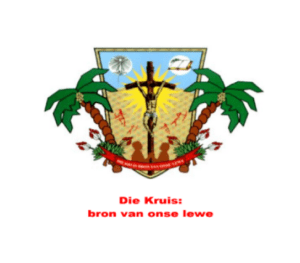
COAT OF ARMS OF DIOCESE KEIM0ES-UPINGTON:
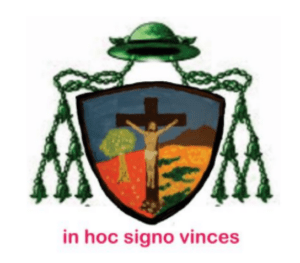
Predecessors Former Bishops: Bishop John Maria Simon, OSFS, consecrated 21 September 1898, Titular Bishop of Thaumacos, died 21 November 1932.
Bishop Odilon Fages, OSFS, Titular Bishop of Mulia, consecrated 30 September 1928, died 14 October 1939.
Bishop Henry Thünemann, OSFS, Titular Bishop of Coridala, consecrated 3 October 1940, named first Bishop of the Diocese of Keimoes 1951, retired due to ill health 12 September 1962, nominated Assistant at the Pontifical Throne 16 May 1965, died 18 August 1965.
Bishop Francis Esser, OSFS, consecrated 30 March 1949, named Co-adjutor Bishop to ailing Bishop Thünemann 1956; succeeded to the See of Keimoes 12 September 1962, died 8 December 1966.
Bishop John Baptist Minder, OSFS, consecrated 10 January 1968, resigned 5 July 2000. Died 13 August 2009.
History of the Diocese The Diocese of Keimoes-Upington was initially part of the Vicariate of the Cape of Good Hope. Bishop Grimley took seriously his responsibility to reach out to Catholics in his very vast vicariate. Between 1861 and 1869 he made three apostolic visitations to the Namaqualand. The first parish priest, Fr. Meagher, was installed in Springbok in 1861 and the second, Fr Quaid, in 1863. In 1865 Bishop Grimley laid the foundation stone of the first Catholic church in Springbok, St. Columbanus. The establishment of the Central Prefecture in 1871 was the dream and goal of Bishop Grimley. This new prefecture covered the territory between the Western and Eastern Vicariates, from George in the south to the Orange River in the north; presently the territory of the dioceses of Oudtshoorn and Keimoes-Upington.
The Central Prefecture was entrusted to the care of the Missionaries of Lyon in 1872 (known today as the Society of African Missions – SMA). The Missions of Namaqualand formed the northern part of the Central Prefecture and were entrusted to the Oblates of St. Francis de Sales in 1882. In 1884 this northern territory was established as a separate Prefecture Apostolic and became the Orange River Vicariate in 1898 when Bishop Simon was appointed it first Vicar Apostolic. The name was changed to Keimoes Vicariate in 1940.
On the establishment of the Ecclesiastical Hierarchy in South Africa, 11 January 1951, the Vicariate became known as the Diocese of Keimoes. Canonical possession of the new See was taken on the 10 July 1951. The name of the Diocese was changed to Diocese of Keimoes-Upington by the Sacred Congregation for the Evangelisation of Peoples in 1985.
This Diocese is bounded on the West by the Atlantic Ocean; on the North, by the Republic of Namibia and the Republic of Botswana; on the East it extends to the eastern limit of the Z.F. Mgcawu District and Prieska districts of Pixley ka Seme District Municipality; in the South to the southern boundaries of Prieska, Kenhardt Williston, Calvinia; and includes the Matzikama District of the Western Cape.
Postal Address:PO Box 323, Keimoes 8860.
Tel: 054 461 1846 or 054 461 1517.
Fax: (+27) 86 751 1452
Email: omikeimoes@telkomsa.net
Website: www.catholic-keimoes.org.za
Communication officer: Fr. DESMOND DOMKRAG
Contact: 0783828146, desmond1@gmail.com
Province of Bloemfontein
Patron: St Patrick
Bishop: Rt Fr. Michael Rasello, Diocesan Administrator ofKroonstad Diocese
Postal Address:
The Peak, PO Box 129, Kroonstad 9500.
Tel: 056 212 6639
Fax: 056 212 7705.
Email: bishop.krd@act.co.za
Coat of Arms and Motto
Predecessors
- Rt. Rev Leo Klerlein, CSSp was first Vicar Apostolic of Kroonstad 8 April 1935. He died 22nd May 1950.
- Rt. Rev Bishop G van Velsen, OP, the first Bishop of the Diocese of Kroonstad (11 January 1951) retired 15 November 1975, He died on 3 March 1996 in Holland.
- Rt. Rev. Bishop J.L Brenninkmeijer, OP, second Bishop of the Diocese of Kroonstad. (24th July 1977). He died 2nd July 2003.
- Rt. Rev Bishop S. Brislin, third Bishop of the Diocese of Kroonstad. Ordained Bishop 28th January, 2007. Transferred to the Archdiocese of Cape Town on 7th February, 2010.
- Rt. Rev Bishop PJ Holiday, fourth Bishop of the Diocese of Kroonstad, Ordained Bishop 25th June 2011, Resigned 12 December 2022.
History of the Diocese
Until 1924 this territory formed part of the Kimberley Vicariate. By a decree dated 26 November 1923, the Sacred Congregation de Propaganda Fide erected the northern half of the Orange Free State into a Prefecture and entrusted its care to the German Province of the Holy Ghost Fathers. On 24 March 1924, the Very Rev Leo Klerlein, CSSp, was appointed first Prefect Apostolic. On 8 April 1935, Kroonstad was constituted a Vicariate and Mgr Klerlein appointed first Vicar Apostolic.
In February 1948 the Eastern part was separated and constituted as the Bethlehem Vicariate; the Western part kept the name of Kroonstad Vicariate. In March 1948, Rt. Rev Mgr G Van Velsen, OP was appointed Apostolic Administrator of this territory which was entrusted to the Dominican Fathers of the Dutch Province.
When the Ecclesiastical Hierarchy was established in South Africa on 11 January 1951, the Vicariate became known as the Diocese of Kroonstad.
The Diocese comprises the civil districts of Kroonstad, Virginia, Theunissen, Welkom, Odendaalsrus, Allanridge, Bothaville, Viljoenskroon, Parys, Vredefort, Koppies, Sasolburg, Heilbron, Hennenman, Ventersburg and parts of Winburg, and Hoopstad, Wesselsbron
More Info: Here
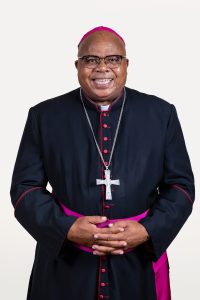 Province of Bloemfontein
Province of Bloemfontein
Patron: The Immaculate Heart of Mary
Bishop: MRt. Rev Bishop Duncan Tsoke, Bishop of Kimberley
Coat of Arms and Motto
Predecessors
- Rt Rev Anthony Gaughren OMI was consecrated 8 June 1886, Titular Bishop of Prienne. He died 15 January 1901.
- Rt Rev Matthew Gaughren OMI was consecrated 23 January 1902, Titular Bishop of Tentyra and died 1 June 1914.
- Rt Rev Bishop Charles Cox OMI, Titular Bishop of Dioclea, Vicar Apostolate of the Transvaal Vicariate, acted as Administrator of the Kimberley Vicariate from September 1914 to 5 November 1924 when the Rt Rev Hermann Joseph Meysing OMI was appointed Administrator Apostolic, consecrated 19 March 1930, Titular Bishop of Mina and appointed Archbishop of Bloemfontein 11 January 1951 and acted as Administrator \apostolic of the Kimberley Diocese from 11 January 1951 to 27 August 1953. He died 21 October 1963.
- Rt Rev Bishop John Bokenfohr OMI was consecrated 3 May 1953, resigned 1 July and died 9 August 1982 as Cornwall, Canada.
- Rt Rev Erwin Hecht OMI Ordained Bishop of the Titular See of Obba 11 May 1972 as Auxiliary to Bishop Bokenfohr OMI, he was appointed Bishop of Kimberley on 1 July and installed on 24 November 1974. Resigned 2009.
History of the Diocese
Separated from the Vicariate of natal 1st June 1886, the Diocese of Kimberley, established 11 January 1951, is the North of Orange River and comprises territory in the northern part of the Cape Province. The civil districts in the Northern Cape are: Barkly West, hay, Herbert, Kuruman, Mafikeng, Taung, Vryburg. The section of Botswana which is south of the Tropic of Capricorn (comprising the civil districts of Lobatse, Gaborone, Molepolole, part of Serowe and Tsabong) was detached from Kimberley Diocese on 24 April 1959. The Roman Catholic Diocese of Kimberly is a thriving and dynamic community of faith, encompassing 196 parishes across the region. Rooted in a rich tradition of Catholicism and inspired by the Holy Spirit, our diocese is a beacon of hope, love, and compassion for all who seek to grow in their faith and serve their fellow community members. Within our diocese, diversity is celebrated, and inclusivity is a guiding principle. Every individual, regardless of their background or circumstances, is warmly welcomed into our close-knit family of believers. Our commitment is to serve not only the spiritual needs of our parishioners but also their emotional and physical well-being, recognizing that each person's journey is unique. Our vision for the future is one of unity and shared purpose. We aspire to foster a deep and personal relationship with God in the hearts of all our members, encouraging them to live out the Gospel values in their daily lives. As we journey together, we extend our hands in service to those in need, both within our diocese and the wider community.
The Roman Catholic Diocese of Kimberly is dedicated to continuous growth and spiritual development, aiming to make a positive impact on the world around us. We are a community that embraces the challenges of our time with unwavering faith and the timeless values of love, acceptance, and respect. Through our collective efforts, we hope to inspire others and spread the message of Christ’s love to all corners of our region and beyond.
Our Mission
The Roman Catholic Diocese of Kimberly, a diverse and vibrant community of faith, is dedicated to spreading the Gospel of Jesus Christ and serving the spiritual, emotional, and physical needs of our parishioners and the wider community. Rooted in our rich tradition and guided by the Holy Spirit, we strive to be a beacon of hope, love, and compassion, providing a nurturing and inclusive environment where all are welcome.
Value Statement
In the Roman Catholic Diocese of Kimberly, our values are the bedrock of our identity and the compass guiding our actions. Rooted in the teachings of Jesus Christ and animated by the Holy Spirit, we hold these core values dear to our hearts: Faith Centered Living: We embrace a life of faith, seeking to deepen our relationship with God and allowing His teachings to illuminate our path.
Inclusivity and Diversity:
We celebrate the uniqueness of each individual, fostering a community where all are welcomed, accepted, and valued for who they are.
Compassionate Service:
Grounded in love, we are dedicated to serving the spiritual, emotional, and physical needs of our community and beyond, extending a helping hand to those in need. Unity in Diversity: We cherish the richness of our diverse community, recognizing that our unity is strengthened by the variety of backgrounds, cultures, and experiences within our diocese.
Continuous Growth:
Committed to lifelong learning and spiritual development, we actively seek opportunities for personal and collective growth, adapting to the evolving needs of our community and the world.
Stewardship:
Acknowledging that all we have is a gift from God, we practice responsible stewardship of our resources, both material and spiritual, for the benefit of present and future generations.
Authenticity:
We strive to live authentically, aligning our words and actions with the Gospel values, fostering an environment of trust, transparency, and integrity. In living out these values, we aspire to be a shining light in our community, reflecting the love of Christ and inspiring positive change in the world around us.
Apostolic nunciature
Archbishop
Apostolic nunciature, to Southern Africa
South Africa, Bots, Kingdom of Eswatini (former SWAZILAND), Lesotho and Namibia.
TROIKA
Cardinal Stephen Brislin
SACBC President
Archbishops Zolile Mpambani SCI
First Vice President
Archbishop Siegfried Jwara CMM
Second Vice President
Office Bearers
Office Bearers
- The plenary session shall elect a President, a First Vice-President and a Second Vice-President of the Conference for a term of three years renewable for a further term
- The Vice-Presidents shall assume such rights and duties as may be assigned to them from time to time by the President or the plenary session or the Administrative Board
- Should the President be impeded or absent from the Conference Territory, the first Vice-President shall be Acting President; assuming all the rights and duties of the President; should the first Vice- President also be impeded or absent from the Territory, the role of Acting President shall devolve on the second Vice-President, and should he also be impeded or absent from the Territory, an Acting President shall be elected by the Administrative Board from amongst its members
DEPARTMENT FOR CHRISTIAN FORMATION, LITURGY AND CULTURE
Bishop Robert Mphiwe
Chairperson
Bishop Vusumuzi Mazibuko OMI
Vice-Chairperson
Bishop Sithembele Sipuka
Third Episcopal Member
DEPARTMENT FOR FORMATION, LIFE AND MINISTRY OF THE CLERGY
Bishop Masilo Selemela
Chairperson
Bishop S. David OMI
Vice-Chairperson
Bishop Noel Rucastle
Third Episcopal Member
DEPARTMENT FOR FORMATION, LIFE AND APOSTOLATE OF THE LAITY
Bishop Vincent Zungu OFM
Chairperson
Bishop Elias Zondi
Vice-Chairperson
Bishop Siphiwo Vanqa SAC
Third Episcopal Member
DEPARTMENT FOR CATHOLIC SOCIAL ACTION
Bishop Thulani Mbuyisa CMM
Chairperson
Bishop José Luís Gerardo Ponce de León IMC (DHPI)
Vice-Chairperson
Bishop Joseph Kizito
Third Episcopal Member
DEPARTMENT FOR ECUMENISM AND INTER-RELIGIOUS DIALOGUE
Bishop Graham Rose
Chairperson
Bishop Adam Musialek SCI
Vice-Chairperson
Bishop Edward Risi OMI
Third Episcopal Member
DEPARTMENT FOR FINANCE
Bishop Sithembele Sipuka
Chairperson
Bishop Duncan Tsoke
Vice-Chairperson
Bishop Stanley Dziuba OSSPE
Third Episcopal Member
LIAISON BISHOPS
DEPARTMENT FOR CATHOLIC FORMATION, LITURGY AND CULTURE
Bishop S. David OMI
ICEL
Bishop Neil Frank OMI
OWNERS OF SCHOOLS
DEPARTMENT FOR FORMATION, LIFE AND APOSTOLATE OF THE CLERGY
Bishop R. Mphiwe
SACOP and ONGOING
FORMATION OF PRIESTS
Bishop N. Rucastle
PROFESSIONAL CONDUCT
Archbishop Dabula Mpako
SPECIAL MINISTRIES
DEPARTMENT FOR CATHOLIC SOCIAL ACTION
Bishop S. Dziuba OSPPE
CARITAS SA
Bishop Joseph Kizito
MIGRANTS, REFUGEES, AND HUMAN TRAFFICKING
Bishop Elias Zondi
APOSTLESHIP OF THE SEA
Bishop Neil Frank OMI
CATHCA
Bishop José Luís Gerardo Ponce de León IMC
CARITAS ESWATINI
Bishop João Rodrigues
CPLO
Cardinal S. Brislin
COMMUNICATION
Archbishop F. Nubuasah SVD
CARITAS BOTSWANA
Bishop S. David OMI
REAP and RDSP
Bishop Siphiwo Vanqa SAC
IMBISA
Bishop Vusumuzi Mazibuko OMI,
LCCL
Bishop Noel Rucastle, Bishops Joseph Kizito, Bishop Duncan Tshoke
SECAM REPRESENTATIVES
Bishop José Ponce de León IMC
MISSION COUNCIL
Bishop Neil Frank OMI
FUTURE VISION
Fr. Hugh O'Connor
SACBC Secretary General
Sr Dominica Mkhize FSF
Associate Secretary General
All SACBC Offices ⇒
SACBC Khanya House Staff
RECEPTION

Letticia Ramaphoko
Reception/Secretariat Secretary
COMMUNICATIONS OFFICE

Sheila Pires
Communications Officer
YOUTH OFFICE
ARCHIVES

Sindiso Mkhwebu
Archives
CHRISTIAN FORMATION, LITURGY, AND CULTURE
CATECHETICS CHRISTIAN FORMATION, LITURGY, AND CULTURE ||
LAITY OFFICE
LENTEN APPEAL OFFICE
JUSTICE AND PEACE

Fr. Stan Muyebe, OP
Staff Member
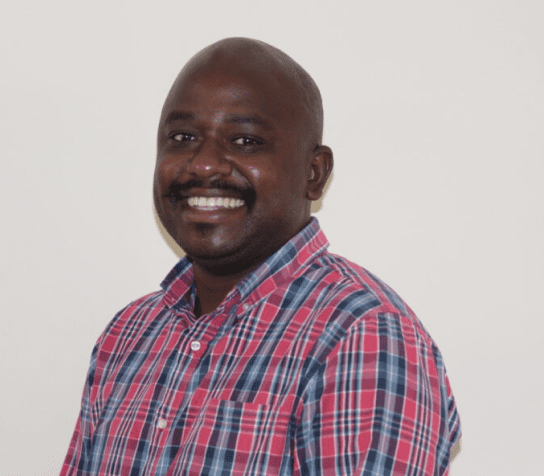
Robert Mafinyori
Staff Member
JUSTICE AND PEACE
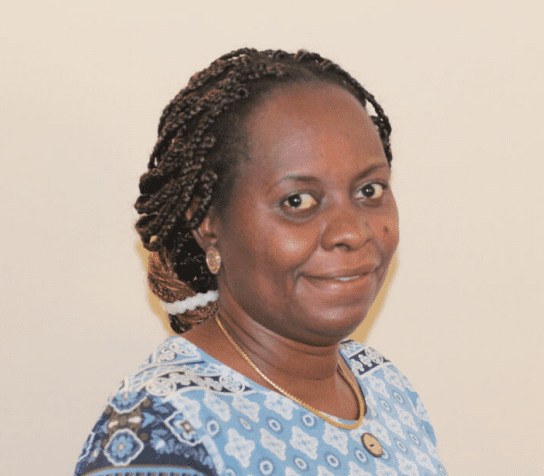
Angelique Naweza
Staff Member
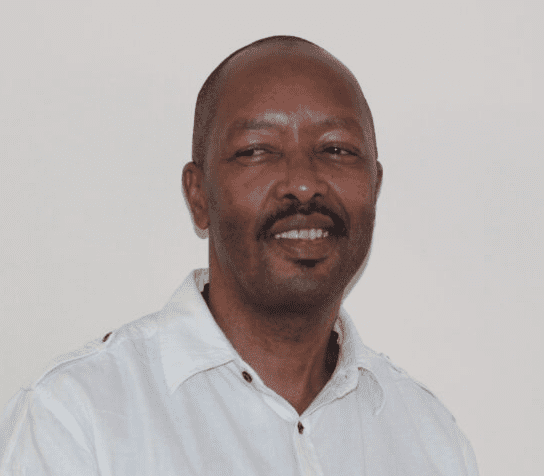
Philani Mkhize
Staff Member
JUSTICE AND PEACE

Shaka Dzebu
Staff Member
ACCOUNTS DEPARTMENT

Geraldine Hedley
Finance Manager
Migrants, Refugees and human trafficking
ECUMENISM & INTER- RELIGIOUS DIALOGUE

Fr. Bonaventure
Co-ordinating Secretary – Ecumenism/Inter-religious dialogue
AIDS OFFICE

Kabelo Masemola
Staff Member
AIDS OFFICE
AIDS OFFICE
DENIS HURLEY PEACE INSTITUTE (DHPI)

Johan Viljoen
Director
ECUMENISM & INTER- RELIGIOUS DIALOGUE

Reabetswe Tloubatla
Staff Member
ADMINISTRATION DEPARTMENT

Joseph Phalana
Garden
ADMINISTRATION DEPARTMENT

Reuben Mabetha
Maintenance
ADMINISTRATION DEPARTMENT

Collen Mabetha
Garden
Protocols
The Catholic Church in Southern Africa, under the leadership and guidance of the Southern African Catholic Bishops’ Conference (SACBC) cannot be satisfied with merely reacting to allegations of sexual abuse of the young. Rather it wants to be proactive in preventing abuse.
In fact the Bishops’ Conference is convinced that the protection of all life and all persons is a priority Gospel imperative. All life is part of God’s plan, therefore the Catholic Church wants to develop approaches to life issues that are a ‘seamless garment’.
These approaches include the promotion of:
- A Culture of Life in order to deal with Abortion, Euthanasia and other life related medico-ethical issues, foetal stem cell experimentation.
- A Culture of respect, acceptance and inclusion of all persons, especially those with disabilties and special needs
- A Culture of Safety for Children. While the primary responsibility for the safety and well-being of children lies with the parents and the immediate family, the safety of children demands the active engagement of the whole community, and especially the Church.
The Church’s Ministry to the young is an essential part of the mission given to it by Christ Himself. For that reason the Conference mandates the establishment of an Ad Hoc Committee under the supervision of the Secretary General to oversee policies and procedures necessary for the Protection of Minors and Vulnerable adults.
Child Protection Policy and procedures –‘Safeguarding our Children’ – – Download the PDF here.
Document status: This Document is approved for comment, circulation and use ‘ad experimentum’
A Culture of Integrity in Ministry. The Conference document ‘Integrity in Ministry’ seeks to establish standards of professional behaviour derived for the values of the Gospel, as well as the professional principles of transparency and accountability for Religious, Clerics and lay Church workers. Download ‘Integrity on Ministry’ here.
Document status: This document is approved for use ‘ad experimentum’.
The Catholic Bishops are committed to following norms and standards that meet the requirements of Canon Law and Civil Law. Consequently, all rumours, allegations, reports or complaints of sexual abuse or misconduct will be investigated, first of all to establish whether they are credible or not. These preliminary investigations are done by Provincial Professional Conduct Committees based in each Archdiocese. The overall responsibility for ensuring that these procedures are followed conscientiously lies with the SACBC Professional Conduct Committee.
Document status: This document is approved for use ‘ad experimentum’.
The Catholic Bishops are committed to following norms and standards that meet the requirements of Canon Law and Civil Law. Consequently, all rumours, allegations, reports or complaints of sexual abuse or misconduct will be investigated, first of all to establish whether they are credible or not. These preliminary investigations are done by Provincial Professional Conduct Committees based in each Archdiocese. The overall responsibility for ensuring that these procedures are followed conscientiously lies with the SACBC Professional Conduct Committee.
Documents relating to a sexual abuse of Minors:
“Protocol for the investigation of complaints of Sexual Abuse of minors by Clerics and Religious – 2013 edition” – Download PDF here.
Document Status: Approved for use in the Territory of the Southern African Catholic Bishops Conference from November 2011. This edition replaces all other protocols and procedures.
“Vade Mecum for Ordinaries” – Download PDF here
Document Status: Under constant revision.
“Protocol for the preliminary investigation of sexual misconduct between adults” – Download the PDF here
Document
Status: Approved for use ‘ad experimentum’ Currently under review.
“PROTOCOL FOR THE PRELIMINARY INVESTIGATION OF COMPLAINTS AGAINST CLERICS AND RELIGIOUS IN REGARD TO CANONICAL OFFENCES (other than Sexual Abuse of Minors)” – Download the PDF Document
As with most law systems, transgressions committed are tried under the law in force at the time.
(Historical versions of the Protocols are available for download here)
South African Law
“Childrens Act”
“Childrens Justice Act”
“Sexual Offenders Act”
All Professional conduct enquiries are to be directed to E-mail: SecretaryGeneral@sacbc.org.za
All files available for download are licensed under Creative Commons Licence 3, unless expressly stated.


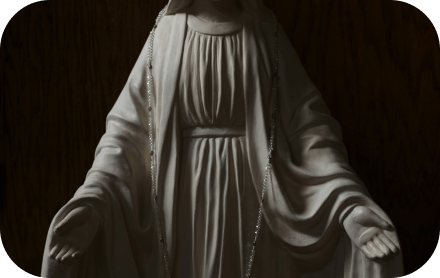
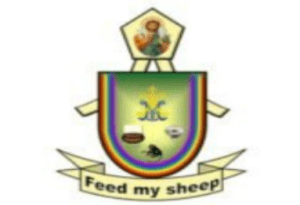
Follow us on all our socials here